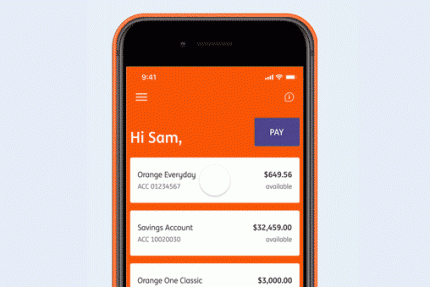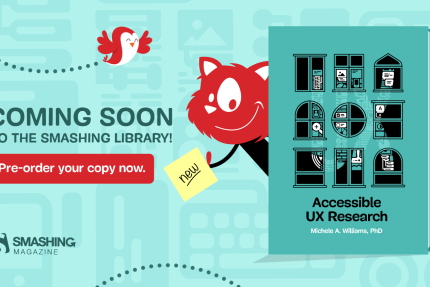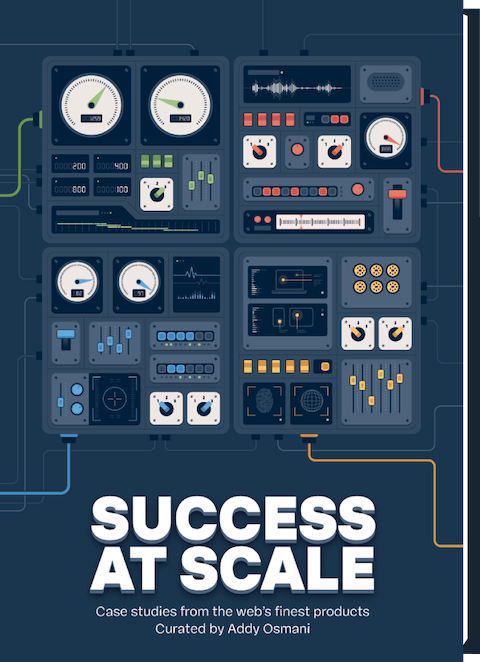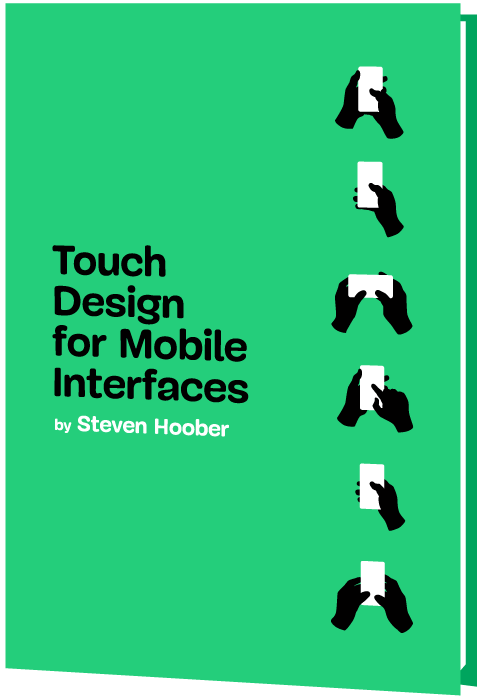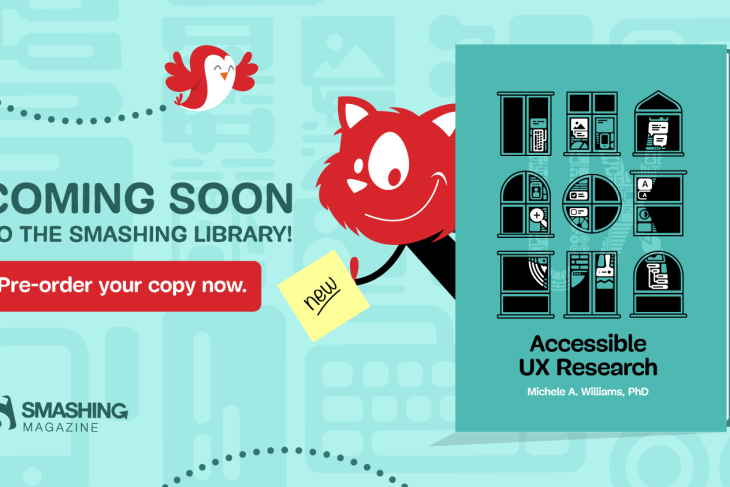
Turning User Research Into Real Organizational Change
Turning User Research Into Real Organizational Change Turning User Research Into Real Organizational Change Paul Boag 2025-07-01T10:00:00+00:00 2025-07-02T15:03:33+00:00 This article is sponsored by Lyssna We’ve all been there: you pour your heart and soul into conducting meticulous user research. You gather insightful data, create detailed […]
Accessibility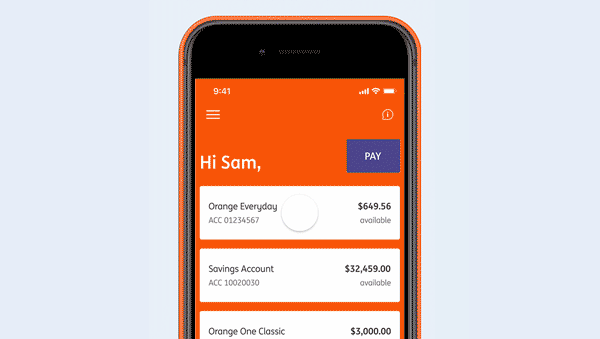
Can Good UX Protect Older Users From Digital Scams?
Can Good UX Protect Older Users From Digital Scams? Can Good UX Protect Older Users From Digital Scams? Carrie Webster 2025-06-25T12:00:00+00:00 2025-06-25T15:04:30+00:00 A few years ago, my mum, who is in her 80s and not tech-savvy, almost got scammed. She received an email from what […]
Accessibility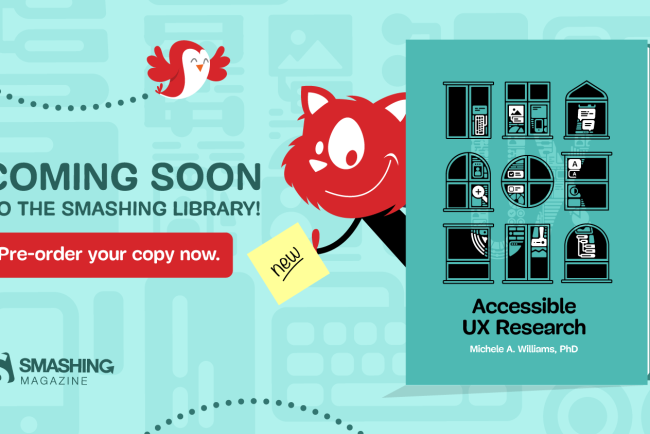
Meet Accessible UX Research, A Brand-New Smashing Book
Meet Accessible UX Research, A Brand-New Smashing Book Meet Accessible UX Research, A Brand-New Smashing Book Vitaly Friedman 2025-06-20T16:00:00+00:00 2025-06-25T15:04:30+00:00 UX research can take so much of the guesswork out of the design process! But it’s easy to forget just how different people are and […]
Accessibility

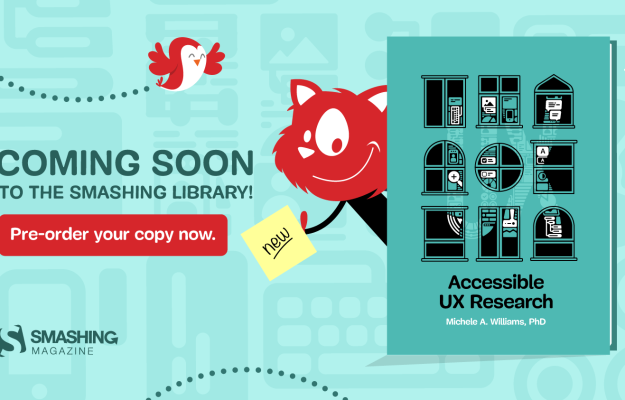



Turning User Research Into Real Organizational Change
Turning User Research Into Real Organizational Change Turning User Research Into Real Organizational Change Paul Boag 2025-07-01T10:00:00+00:00 2025-07-02T15:03:33+00:00 This article is sponsored by Lyssna We’ve all been there: you pour your heart and soul into conducting meticulous user research. You gather insightful data, create detailed […]
Accessibility
Turning User Research Into Real Organizational Change
Paul Boag 2025-07-01T10:00:00+00:00
2025-07-02T15:03:33+00:00
This article is sponsored by Lyssna
We’ve all been there: you pour your heart and soul into conducting meticulous user research. You gather insightful data, create detailed reports, and confidently deliver your findings. Yet, months later, little has changed. Your research sits idle on someone’s desk, gathering digital dust. It feels frustrating, like carefully preparing a fantastic meal, only to have it left uneaten.
There are so many useful tools (like Lysnna) to help us run incredible user research, and articles about how to get the most from them. However, there’s much less guidance about ensuring our user research gets adopted and brings about real change. So, in this post, I want to answer a simple question: How can you make sure your user research truly transforms your organization?
Introduction
User research is only as valuable as the impact it has.
When research insights fail to make their way into decisions, teams miss out on opportunities to improve products, experiences, and ultimately, business results. In this post, we’ll look at:
- Why research often fails to influence organizational change;
- How to ensure strategic alignment so research matters from day one;
- Ways to communicate insights clearly so stakeholders stay engaged;
- How to overcome practical implementation barriers;
- Strategies for realigning policies and culture to support research-driven changes.
By covering each of these areas, you’ll have a clear roadmap for turning your hard-won research into genuine action.
Typical Reasons For Failure
If you’ve ever felt your research get stuck, it probably came down to one (or more) of these issues.
Strategic Misalignment
When findings aren’t tied to business objectives or ROI, they struggle to gain traction. Sharing a particular hurdle that users face will fall on deaf ears if stakeholders cannot see how that problem will impact their bottom line.
Research arriving too late is another hurdle. If you share insights after key decisions are made, stakeholders assume your input won’t change anything. Finally, research often competes with other priorities. Teams might have limited resources and focus on urgent deadlines rather than long-term user improvements.
Communication Issues
Even brilliant research can get lost in translation if it’s buried in dense reports. I’ve seen stakeholders glaze over when handed 30-page documents full of jargon. When key takeaways aren’t crystal clear, decision-makers can’t quickly act on your findings.
Organizational silos can make communication worse. Marketing might have valuable insights that product managers never see, or designers may share findings that customer support doesn’t know how to use. Without a way to bridge those gaps, research lives in a vacuum.
Implementation Challenges
Great insights require a champion. Without a clear owner, research often lives with the person who ran it, and no one else feels responsible. Stakeholder skepticism also plays a role. Some teams doubt the methods or worry the findings don’t apply to real customers.
Even if there is momentum, insufficient follow-up or progress tracking can stall things. I’ve heard teams say, “We started down that path but ran out of time.” Without regular check-ins, good ideas fade away.
Policy And Cultural Barriers
Legal, compliance, or tech constraints can limit what you propose. I once suggested a redesign to comply with new accessibility standards, but the existing technical stack couldn’t support it. Resistance due to established culture is also common. If a company’s used to launching fast and iterating later, they might see research-driven change as slowing them down.
Now that we understand what stands in the way of effective research implementation, let’s explore practical solutions to overcome these challenges and drive real organizational change.
Ensuring Strategic Alignment
When research ties directly to business goals, it becomes impossible to ignore. Here’s how to do it.
Early Stakeholder Engagement
Invite key decision-makers into the research planning phase. I like to host a kickoff session where we map research objectives to specific KPIs, like increasing conversions by 10% or reducing support tickets by 20%. When your stakeholders help shape those objectives, they’re more invested in the results.
Research Objectives Aligned With Business KPIs
While UX designers often focus on user metrics like satisfaction scores or task completion rates, it’s crucial to connect our research to business outcomes that matter to stakeholders. Start by identifying the key business metrics that will demonstrate the value of your research:
- Identify which metrics matter most to the organization (e.g., conversion rate, churn, average order value).
- Frame research questions to directly address those metrics.
- Make preliminary hypotheses about how insights may affect the bottom line.
Develop Stakeholder-Specific Value Propositions
When presenting user research to groups, it’s easy to fall into the trap of delivering a one-size-fits-all message that fails to truly resonate with anyone. Instead, we need to carefully consider how different stakeholders will receive and act on our findings.
The real power of user research emerges when we can connect our insights directly to what matters most for each specific audience:
- For the product team: Show how insights can reduce development time by eliminating guesswork.
- For marketing: Demonstrate how understanding user language can boost ad copy effectiveness.
- For executives: Highlight potential cost savings or revenue gains.
ROI Framework Development
Stakeholders want to see real numbers. Develop simple templates to estimate potential cost savings or revenue gains. For example, if you uncover a usability issue that’s causing a 5% drop-off in the signup flow, translate that into lost revenue per month.
I also recommend documenting success stories from similar projects within your own organization or from case studies. When a stakeholder sees that another company boosted revenue by 15% after addressing a UX flaw, they’re more likely to pay attention.
Research Pipeline Integration
Integrate research tasks directly into your product roadmap. Schedule user interviews or usability tests just before major feature sprints. That way, findings land at the right moment — when teams are making critical decisions.
Regular Touchpoints with Strategic Teams
It’s essential to maintain consistent communication with strategic teams through regular research review meetings. These sessions provide a dedicated space to discuss new insights and findings. To keep everyone aligned, stakeholders should have access to a shared calendar that clearly marks key research milestones. Using collaborative tools like Trello boards or shared calendars ensures the entire team stays informed about the research plan and progress.
Resource Optimization
Research doesn’t have to be a massive, months-long effort each time. Build modular research plans that can scale. If you need quick, early feedback, run a five-user usability test rather than a full survey. For deeper analysis, you can add more participants later.
Addressing Communication Issues
Making research understandable is almost as important as the research itself. Let’s explore how to share insights so they stick.
Create Research One-Pagers
Condense key findings into a scannable one-pager. No more than a single sheet. Start with a brief summary of the problem, then highlight three to five top takeaways. Use bold headings and visual elements (charts, icons) to draw attention.
Implement Progressive Disclosure
Avoid dumping all details at once. Start with a high-level executive summary that anyone can read in 30 seconds. Then, link to a more detailed section for folks who want the full methodology or raw data. This layered approach helps different stakeholders absorb information at their own pace.
Use Visual Storytelling
Humans are wired to respond to stories. Transform data into a narrative by using journey maps, before/after scenarios, and user stories. For example, illustrate how a user feels at each step of a signup process, then show how proposed changes could improve their experience.
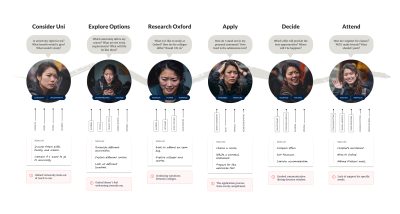
Regular Stakeholder Updates
Keep the conversation going. Schedule brief weekly or biweekly “research highlights” emails or meetings. These should be no more than five minutes and focus on one or two new insights. When stakeholders hear snippets of progress regularly, research stays top of mind.
Interactive Presentations
Take research readouts beyond slide decks. Host workshop-style sessions where stakeholders engage with findings hands-on. For instance, break them into small groups to discuss a specific persona and brainstorm solutions. When people physically interact with research (sticky notes, printed journey maps), they internalize it better.
Overcome Implementation Challenges
Now that stakeholders understand and value your research, let’s make sure they turn insights into action.
Establish Clear Ownership
Assign a dedicated owner for each major recommendation. Use a RACI matrix to clarify who’s Responsible, Accountable, Consulted, and Informed. I like to share a simple table listing each initiative, the person driving it, and key milestones.
When everyone knows who’s accountable, progress is more likely.
RACI Matrix Example
| Initiative | Responsible | Accountable | Consulted | Informed |
|---|---|---|---|---|
| Redesign Signup Flow | UX Lead | Product Manager | Engineering, Legal | Marketing, Support |
| Create One-Pager Templates | UX Researcher | Design Director | Stakeholder Team | All Departments |
Build Implementation Roadmaps
Break recommendations down into phases. For example,
- Phase 1: Quick usability tweaks (1–2 weeks).
- Phase 2: Prototype new design (3–4 weeks).
- Phase 3: Launch A/B test (2–3 weeks).
Each phase needs clear timelines, success metrics, and resources identified upfront.
Address Stakeholder Skepticism
Be transparent about your methods. Share your recruitment screeners, interview scripts, and a summary of analysis steps. Offer validation sessions where stakeholders can ask questions about how the data was collected and interpreted. When they understand the process, they trust the findings more.
Create Support Systems
Even when stakeholders agree, they need help executing. Establish mentorship or buddy programs where experienced researchers or designers guide implementation. Develop training materials, like short “how-to” guides on running usability tests or interpreting survey data. Set up feedback channels (Slack channels, shared docs) where teams can ask questions or share roadblocks.
Monitor And Track Progress
Establish regular progress reviews weekly or biweekly. Use dashboards to track metrics such as A/B test performance, error rates, or user satisfaction scores. Even a more complicated dashboard can be built using no-code tools and AI, so you no longer need to rely on developer support.
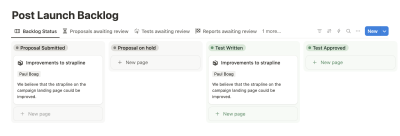
Realign Policies and Culture
Even the best strategic plans and communication tactics can stumble if policies and culture aren’t supportive. Here’s how to address systemic barriers.
Create a Policy Evolution Framework
First, audit existing policies for anything that blocks research-driven changes. Maybe your data security policy requires months of legal review before you can recruit participants. Document those barriers and work with legal or compliance teams to create flexible guidelines. Develop a process for policy exception requests — so if you need a faster path for a small study, you know how to get approval without massive delays.
Technical Infrastructure Adaptation
Technology can be a silent killer of good ideas. Before proposing changes, work with IT to understand current limitations. Document technical requirements clearly so teams know what’s feasible. Propose a phased approach to any necessary infrastructure updates. Start with small changes that have an immediate impact, then plan for larger upgrades over time.
Build Cultural Buy-In
Culture shift doesn’t happen overnight. Share quick wins and success stories from early adopters in your organization. Recognize and reward change pioneers. Send a team-wide shout-out when someone successfully implements a research-driven improvement. Create a champions network across departments, so each area has at least one advocate who can spread best practices and encourage others.

Develop a Change Management Strategy
Change management is about clear, consistent communication. Develop tailored communication plans for different stakeholder groups. For example, executives might get a one-page impact summary, while developers get technical documentation and staging environments to test new designs. Establish feedback channels so teams can voice concerns or suggestions. Finally, provide change management training for team leaders so they can guide their direct reports through transitions.
Measure Cultural Impact
Culture can be hard to quantify, but simple pulse surveys go a long way. Ask employees how they feel about recent changes and whether they are more confident using data to make decisions. Track employee engagement metrics like survey participation or forum activity in research channels. Monitor resistance patterns (e.g., repeated delays or rejections) and address the root causes proactively.
Conclusions
Transforming user research into organizational change requires a holistic approach. Here’s what matters most:
- Strategic Alignment: Involve stakeholders early, tie research to KPIs, and integrate research into decision cycles.
- Effective Communication: Use one-pagers, progressive disclosure, visual storytelling, regular updates, and interactive presentations to keep research alive.
- Implementation Frameworks: Assign clear ownership, build phased roadmaps, address skepticism, offer support systems, and track progress.
- Culture and Policy: Audit and update policies, adapt infrastructure gradually, foster cultural buy-in, and employ change management techniques.
When you bring all of these elements together, research stops being an isolated exercise and becomes a driving force for real, measurable improvements. Keep in mind:
- Early stakeholder engagement drives buy-in.
- Clear research-to-ROI frameworks get attention.
- Ongoing, digestible communication keeps momentum.
- Dedicated ownership and phased roadmaps prevent stalls.
- Policy flexibility and cultural support enable lasting change.
This is an iterative, ongoing process. Each success builds trust and opens doors for more ambitious research efforts. Be patient, stay persistent, and keep adapting. When your organization sees research as a core driver of decisions, you’ll know you’ve truly succeeded.
(yk, il)

Can Good UX Protect Older Users From Digital Scams?
Can Good UX Protect Older Users From Digital Scams? Can Good UX Protect Older Users From Digital Scams? Carrie Webster 2025-06-25T12:00:00+00:00 2025-06-25T15:04:30+00:00 A few years ago, my mum, who is in her 80s and not tech-savvy, almost got scammed. She received an email from what […]
Accessibility
Can Good UX Protect Older Users From Digital Scams?
Carrie Webster 2025-06-25T12:00:00+00:00
2025-06-25T15:04:30+00:00
A few years ago, my mum, who is in her 80s and not tech-savvy, almost got scammed. She received an email from what appeared to be her bank. It looked convincing, with a professional logo, clean formatting, and no obvious typos. The message said there was a suspicious charge on her account and presented a link asking her to “verify immediately.”
She wasn’t sure what to do. So she called me.
That hesitation saved her. The email was fake, and if she’d clicked on the link, she would’ve landed on a counterfeit login page, handing over her password details without knowing it.
That incident shook me. I design digital experiences for a living. And yet, someone I love almost got caught simply because a bad actor knew how to design well. That raised a question I haven’t stopped thinking about since: Can good UX protect people from online scams?
Quite apart from this incident, I see my Mum struggle with most apps on her phone. For example, navigating around her WhatsApp and YouTube apps seems to be very awkward for her. She is not used to accessing the standard app navigation at the bottom of the screen. What’s “intuitive” for many users is simply not understood by older, non-tech users.
Brief Overview Of How Scams Are Evolving Online
Online scams are becoming increasingly sophisticated, leveraging advanced technologies like artificial intelligence and deepfake videos to create more convincing yet fraudulent content. Scammers are also exploiting new digital platforms, including social media and messaging apps, to reach victims more directly and personally.
Phishing schemes have become more targeted, often using personal information taken from social media to craft customised attacks. Additionally, scammers are using crypto schemes and fake investment opportunities to lure those seeking quick financial gains, making online scams more convincing, diverse, and harder to detect.
The Rise In Fraud Targeting Older, Less Tech-savvy Users
In 2021, there were more than 90,000 older victims of fraud, according to the FBI. These cases resulted in US$1.7 billion in losses, a 74% increase compared with 2020. Even so, that may be a significant undercount since embarrassment or lack of awareness keeps some victims from reporting.
In Australia, the ACCC’s 2023 “Targeting Scams” report revealed that Australians aged 65 and over were the only age group to experience an increase in scam losses compared to the previous year. Their losses rose by 13.3% to $120 million, often following contact with scammers on social media platforms.
In the UK, nearly three in five (61%) people aged over 65 have been the target of fraud or a scam. On average, older people who have been scammed have lost nearly £4,000 each.
According to global consumer protection agencies, people over 60 are more likely to lose money to online scams than any other group. That’s a glaring sign: we need to rethink how we’re designing experiences for them.
Older users are disproportionately targeted by scammers for several reasons:
- They’re perceived as having more savings or assets.
- They’re less likely to be digital natives, so they may not spot the red flags others do.
- They tend to trust authority figures and brands, especially when messages appear “official.”
Scammers exploit trust. They impersonate banks, government agencies, health providers, and even family members. The one that scares me the most is the ability to use AI to mimic a loved one’s voice — anyone can be tricked by this.
Cognitive Load And Decision Fatigue In Older Users
Imagine navigating a confusing mobile app after a long day. Now imagine you’re in your 70s or 80s; your eyesight isn’t as sharp, your finger tapping isn’t as accurate, and every new screen feels like a puzzle.
As people age, they may experience slower processing speeds, reduced working memory, and lower tolerance for complexity. That means:
- Multistep processes are harder to follow.
- Unexpected changes in layout or behaviour can cause anxiety.
- Vague language increases confusion.
Decision fatigue hits harder, too. If a user has already made five choices on an app, they may click the 6th button without fully understanding what it does, especially if it seems to be part of the flow.
Scammers rely on these factors. However, good UX can help to reduce it.
The Digital Literacy Gap And Common Pain Points
There’s a big difference between someone who grew up with the internet and someone who started using it in their 60s. Older users often struggle with:
- Recognising safe vs. suspicious links;
- Differentiating between ads and actual content;
- Knowing how to verify sources;
- Understanding terms like “multi-factor authentication” or “phishing”.
They may also be more likely to blame themselves when something goes wrong, leading to underreporting and repeat victimization.
Design can help to bridge some of that gap. But only if we build with their experience in mind.
The Role UX Designers Can Play In Preventing Harm
As UX designers, we focus on making things easy, intuitive, and accessible. But we can also shape how people understand risk.
Every choice, from wording to layout to colour, can affect how users interpret safety cues. When we design for the right cues, we help users avoid mistakes. When we get them wrong or ignore them altogether, we leave people vulnerable.
The good news? We have tools. We have influence. And in a world where digital scams are rising, we can use both to design for protection, not just productivity.
UX As The First Line Of Defence
The list below describes some UX design improvements that we can consider as designers:
1. Clear, Simple Design As A Defence Mechanism
- Simple interfaces reduce user errors and scam risks.
- Use linear flows, fewer input fields, and clear, consistent instructions.
- Helps users feel confident and spot unusual activity.
2. Make Security Cues Obvious And Consistent
- Users rely on visible indicators: padlocks, HTTPS, and verification badges.

- Provide clear warnings for risky actions and unambiguous button labels.
3. Prioritize Clarity In Language
- Use plain, direct language for critical actions (e.g., “Confirm $400 transfer”).
- Avoid vague CTAs like “Continue” or playful labels like “Let’s go!”
- Clear language reduces uncertainty, especially for older users.

4. Focus On Accessibility And Readability
- Use minimum 16px fonts and high-contrast colour schemes.
- Provide clear spacing and headings to improve scanning.
- Accessibility benefits everyone, not just older users.

5. Use Friction To Protect, Not Hinder
- Intentional friction (e.g., verification steps or warnings) can prevent mistakes.
- Thoughtfully applied, it enhances safety without frustrating users.
6. Embed Contextual Education
- Include just-in-time tips, tooltips, and passive alerts.
- Help users understand risks within the flow, not after the fact.
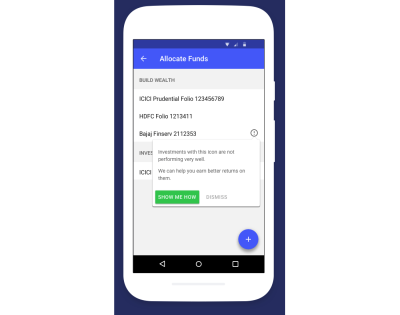
What Can’t UX Fix?
Let’s be realistic: UX isn’t magic. We can’t stop phishing emails from landing in someone’s inbox. We can’t rewrite bad policies, and we can’t always prevent users from clicking on a well-disguised trap.
I personally think that even good UX may be limited in helping people like my mother, who will never be tech-savvy. To help those like her, ultimately, additional elements like support contact numbers, face-to-face courses on how to stay safe on your phone, and, of course, help from family members as required. These are all about human contact touch points, which can never be replaced by any kind of digital or AI support that may be available.
What we can do as designers is build systems that make hesitation feel natural. We can provide visual clarity, reduce ambiguity, and inject small moments of friction that nudge users to double-check before proceeding, especially in financial and banking apps and websites.
That hesitation might be the safeguard we need.
Other Key Tips To Help Seniors Avoid Online Scams
1. Be Skeptical Of Unsolicited Communications
Scammers often pose as trusted entities like banks, government agencies, or tech support to trick individuals into revealing personal information. Avoid clicking on links or downloading attachments from unknown sources, and never share personal details like your Medicare number, passwords, or banking information unless you’ve verified the request independently.
2. Use Strong, Unique Passwords And Enable Two-Factor Authentication
Create complex passwords that combine letters, numbers, and symbols, and avoid reusing passwords across different accounts. Whenever possible, enable two-factor authentication (2FA) to add an extra layer of security to your online accounts.
3. Stay Informed About Common Scams
Educate yourself on prevalent scams targeting seniors, such as phishing emails, romance scams, tech support fraud, and investment schemes. Regularly consult trusted resources like the NCOA and Age UK for updates on new scam tactics and prevention strategies.
4. Verify Before You Act
If you receive a request for money or personal information, especially if it’s urgent, take a moment to verify its legitimacy. Contact the organization directly using official contact information, not the details provided in the suspicious message. Be particularly cautious with unexpected requests from supposed family members or friends.
5. Report Suspected Scams Promptly
If you believe you’ve encountered a scam, report it to the appropriate authorities. Reporting helps protect others and contributes to broader efforts to combat fraud.
For more comprehensive information and resources, consider exploring the following:
- National Council on Aging: 22 Tips for Seniors to Avoid Scams
- Age UK: Avoiding Scams Information Guide
- eSafety Commissioner: Online Scams for Seniors
Examples Of Good Alert/Warning UX In Banking Platforms
I recall my mother not recognising a transaction in her banking app, and she thought that money was being taken from her account. It turns out that it was a legitimate transaction made in a local cafe, but the head office was located in a suburb she was not familiar with, which caused her to think it was fraudulent.
This kind of scenario could easily be addressed with a feature I have seen in the ING banking app (International Netherlands Group). You tap on the transaction to view more information about your transaction.
- ING bank: You can now select a transaction to get more information on the business.

- Banking apps like NAB (National Australia Bank) now interrupt suspicious transfers with messages like, “Have you spoken to this person on the phone? Scammers often pose as trusted contacts.” NAB said that December was the biggest month in 2024 for abandoned payments, with customers scrapping $26 million worth of payments after receiving a payment alert.
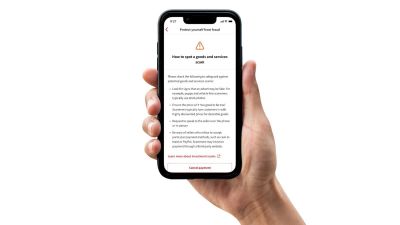
- Macquarie Bank has introduced additional prompts for bank transactions to confirm the user’s approval of all transactions.
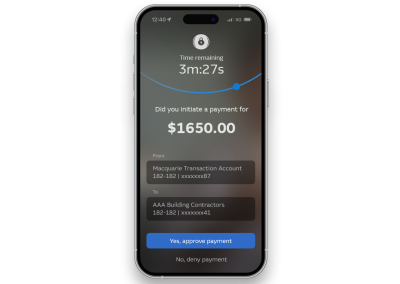
- Monzo Bank has added three security elements to reduce online fraud for banking transactions:
- Verified Locations: Sending or moving large amounts of money from locations that the account holder has marked as safe. This helps block fraudsters from accessing funds if they’re not near these trusted places.
- Trusted Approvers: For large transactions, a trusted contact must give the green light. This adds protection if their phone is stolen or if they want to safeguard someone who may be more vulnerable.
- Secure QR Codes: Account holders can generate a special QR code and keep it stored in a safe place. They scan it when needed to unlock extra layers of security.
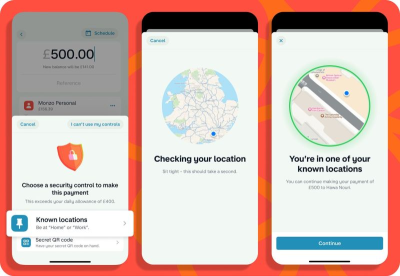
- Email platforms like Gmail highlight spoofed addresses or impersonation attempts with yellow banners and caution icons.

These interventions are not aimed at stopping users, but they can give them one last chance to rethink their transactions. That’s powerful.
Finally, here’s an example of clear UX cues that streamline the experience and guide users through their journey with greater confidence and clarity.
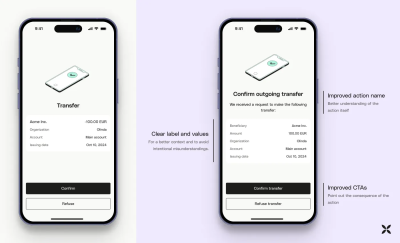
Conclusion
Added security features in banking apps, like the examples above, aren’t just about preventing fraud; they’re examples of thoughtful UX design. These features are built to feel natural, not burdensome, helping users stay safe without getting overwhelmed. As UX professionals, we have a responsibility to design with protection in mind, anticipating threats and creating experiences that guide users away from risky actions. Good UX in financial products isn’t just seamless; it’s about security by design.
And in a world where digital deception is on the rise, protection is usability. Designers have the power and the responsibility to make interfaces that support safer choices, especially for older users, whose lives and life savings may depend on a single click.
Let’s stop thinking of security as a backend concern or someone else’s job. Let’s design systems that are scam-resistant, age-inclusive, and intentionally clear. And don’t forget to reach out with the additional human touch to help your older family members.
When it comes down to it, good UX isn’t just helpful — it can be life-changing.
(yk)

Meet Accessible UX Research, A Brand-New Smashing Book
Meet Accessible UX Research, A Brand-New Smashing Book Meet Accessible UX Research, A Brand-New Smashing Book Vitaly Friedman 2025-06-20T16:00:00+00:00 2025-06-25T15:04:30+00:00 UX research can take so much of the guesswork out of the design process! But it’s easy to forget just how different people are and […]
Accessibility
Meet Accessible UX Research, A Brand-New Smashing Book
Vitaly Friedman 2025-06-20T16:00:00+00:00
2025-06-25T15:04:30+00:00
UX research can take so much of the guesswork out of the design process! But it’s easy to forget just how different people are and how their needs and preferences can vary. We can’t predict the needs of every user, but we shouldn’t expect different people using the product in roughly the same way. That’s how we end up with an incomplete, inaccurate, or simply wrong picture of our customers.
There is no shortage of accessibility checklists and guidelines. But accessibility isn’t a checklist. It doesn’t happen by accident. It’s a dedicated effort to include and consider and understand different needs of different users to make sure everyone can use our products successfully. That’s why we’ve teamed up with Michele A. Williams on a shiny new book around just that.
Meet Accessible UX Research, your guide to making UX research more inclusive of participants with different needs — from planning and recruiting to facilitation, asking better questions, avoiding bias, and building trust. Pre-order the book.
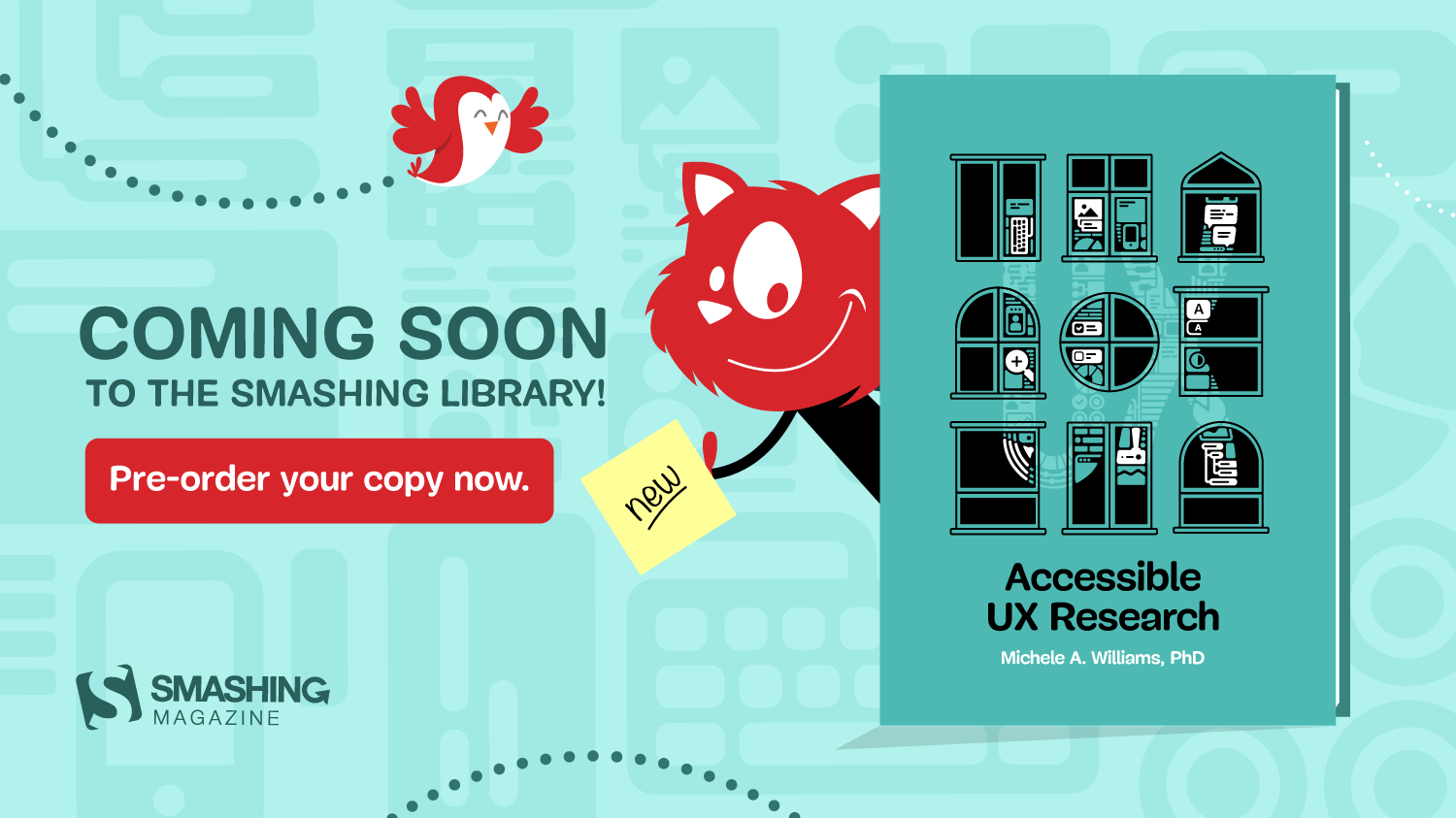
Print + eBook
{
“sku”: “accessible-ux-research”,
“type”: “Book”,
“price”: “44.00”,
“prices”: [{
“amount”: “44.00”,
“currency”: “USD”,
“items”: [
{“amount”: “34.00”, “type”: “Book”},
{“amount”: “10.00”, “type”: “E-Book”}
]
}, {
“amount”: “44.00”,
“currency”: “EUR”,
“items”: [
{“amount”: “34.00”, “type”: “Book”},
{“amount”: “10.00”, “type”: “E-Book”}
]
}
]
}
$
44.00
Quality hardcover. Free worldwide shipping starting in August 2025.
100 days money-back-guarantee.
eBook
{
“sku”: “accessible-ux-research-ebook”,
“type”: “E-Book”,
“price”: “19.00”,
“prices”: [{
“amount”: “19.00”,
“currency”: “USD”
}, {
“amount”: “19.00”,
“currency”: “EUR”
}
]
}
$
19.00
Free!
DRM-free, of course. ePUB, Kindle, PDF available for download later this summer.
Included with your Smashing Membership.
Get the eBook
Download PDF, ePUB, Kindle.
Thanks for being smashing! ❤️
About The Book
The book isn’t a checklist for you to complete as a part of your accessibility work. It’s a practical guide to inclusive UX research, from start to finish. If you’ve ever felt unsure how to include disabled participants, or worried about “getting it wrong,” this book is for you. You’ll get clear, practical strategies to make your research more inclusive, effective, and reliable.
Inside, you’ll learn how to:
- Plan research that includes disabled participants from the start,
- Recruit participants with disabilities,
- Facilitate sessions that work for a range of access needs,
- Ask better questions and avoid unintentionally biased research methods,
- Build trust and confidence in your team around accessibility and inclusion.
The book also challenges common assumptions about disability and urges readers to rethink what inclusion really means in UX research and beyond. Let’s move beyond compliance and start doing research that reflects the full diversity of your users. Whether you’re in industry or academia, this book gives you the tools — and the mindset — to make it happen.
High-quality hardcover. Written by Dr. Michele A. Williams. Cover art by Espen Brunborg. Print shipping in August 2025. eBook available for download later this summer. Pre-order the book.
Contents
- Disability mindset: For inclusive research to succeed, we must first confront our mindset about disability, typically influenced by ableism.
- Diversity of disability: Accessibility is not solely about blind screen reader users; disability categories help us unpack and process the diversity of disabled users.
- Disability in the stages of UX research: Disabled participants can and should be part of every research phase — formative, prototype, and summative.
- Recruiting disabled participants: Recruiting disabled participants is not always easy, but that simply means we need to learn strategies on where to look.
- Designing your research: While our goal is to influence accessible products, our research execution must also be accessible.
- Facilitating an accessible study: Preparation and communication with your participants can ensure your study logistics run smoothly.
- Analyzing and reporting with accuracy and impact: How you communicate your findings is just as important as gathering them in the first place — so prepare to be a storyteller, educator, and advocate.
- Disability in the UX research field: Inclusion isn’t just for research participants, it’s important for our colleagues as well, as explained by blind UX Researcher Dr. Cynthia Bennett.
Who This Book Is For
Whether a UX professional who conducts research in industry or academia, or more broadly part of an engineering, product, or design function, you’ll want to read this book if…
- You have been tasked to improve accessibility of your product, but need to know where to start to facilitate this successfully.
- You want to establish a culture for accessibility in your company, but not sure how to make it work.
- You want to move from WCAG/EAA compliance to established accessibility practices and inclusion in research practices and beyond.
- You want to improve your overall accessibility knowledge and be viewed as an Accessibility Specialist for your organization.
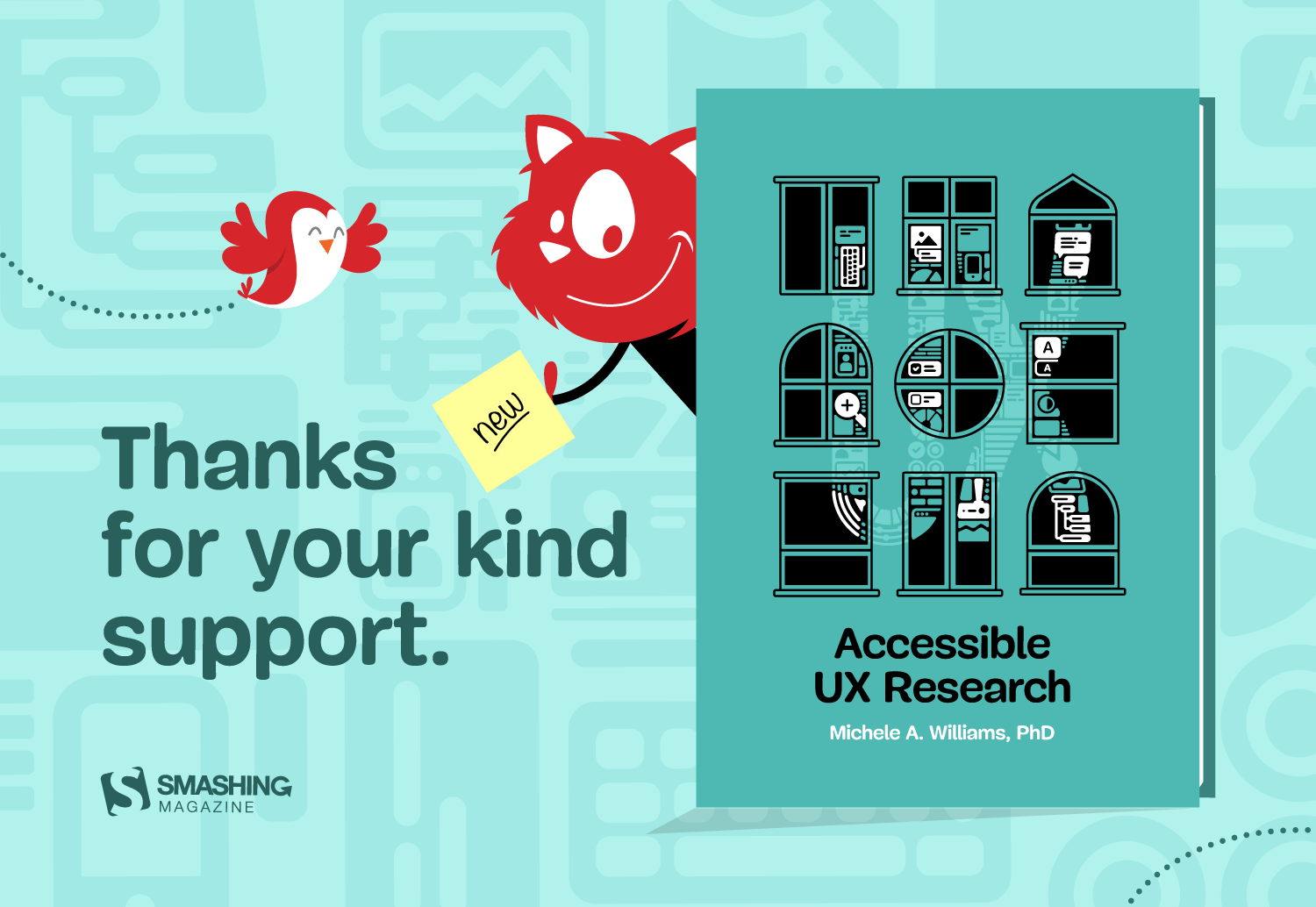
Print + eBook
{
“sku”: “accessible-ux-research”,
“type”: “Book”,
“price”: “44.00”,
“prices”: [{
“amount”: “44.00”,
“currency”: “USD”,
“items”: [
{“amount”: “34.00”, “type”: “Book”},
{“amount”: “10.00”, “type”: “E-Book”}
]
}, {
“amount”: “44.00”,
“currency”: “EUR”,
“items”: [
{“amount”: “34.00”, “type”: “Book”},
{“amount”: “10.00”, “type”: “E-Book”}
]
}
]
}
$
44.00
Quality hardcover. Free worldwide shipping starting in August 2025.
100 days money-back-guarantee.
eBook
{
“sku”: “accessible-ux-research-ebook”,
“type”: “E-Book”,
“price”: “19.00”,
“prices”: [{
“amount”: “19.00”,
“currency”: “USD”
}, {
“amount”: “19.00”,
“currency”: “EUR”
}
]
}
$
19.00
Free!
DRM-free, of course. ePUB, Kindle, PDF available for download later this summer.
Included with your Smashing Membership.
Get the eBook
Download PDF, ePUB, Kindle.
Thanks for being smashing! ❤️
About the Author
 Dr. Michele A. Williams is owner of M.A.W. Consulting, LLC – Making Accessibility Work. Her 20+ years of experience include influencing top tech companies as a Senior User Experience (UX) Researcher and Accessibility Specialist and obtaining a PhD in Human-Centered Computing focused on accessibility. An international speaker, published academic author, and patented inventor, she is passionate about educating and advising on technology that does not exclude disabled users.
Dr. Michele A. Williams is owner of M.A.W. Consulting, LLC – Making Accessibility Work. Her 20+ years of experience include influencing top tech companies as a Senior User Experience (UX) Researcher and Accessibility Specialist and obtaining a PhD in Human-Centered Computing focused on accessibility. An international speaker, published academic author, and patented inventor, she is passionate about educating and advising on technology that does not exclude disabled users.
Testimonials
“Accessible UX Research stands as a vital and necessary resource. In addressing disability at the User Experience Research layer, it helps to set an equal and equitable tone for products and features that resonates through the rest of the creation process. The book provides a solid framework for all aspects of conducting research efforts, including not only process considerations, but also importantly the mindset required to approach the work.
This is the book I wish I had when I was first getting started with my accessibility journey. It is a gift, and I feel so fortunate that Michele has chosen to share it with us all.”
Eric Bailey, Accessibility Advocate
“User research in accessibility is non-negotiable for actually meeting users’ needs, and this book is a critical piece in the puzzle of actually doing and integrating that research into accessibility work day to day.”
Devon Pershing, Author of The Accessibility Operations Guidebook
“Our decisions as developers and designers are often based on recommendations, assumptions, and biases. Usually, this doesn’t work, because checking off lists or working solely from our own perspective can never truly represent the depth of human experience. Michele’s book provides you with the strategies you need to conduct UX research with diverse groups of people, challenge your assumptions, and create truly great products.”
Manuel Matuzović, Author of the Web Accessibility Cookbook
“This book is a vital resource on inclusive research. Michele Williams expertly breaks down key concepts, guiding readers through disability models, language, and etiquette. A strong focus on real-world application equips readers to conduct impactful, inclusive research sessions. By emphasizing diverse perspectives and proactive inclusion, the book makes a compelling case for accessibility as a core principle rather than an afterthought. It is a must-read for researchers, product-makers, and advocates!”
Anna E. Cook, Accessibility and Inclusive Design Specialist
Technical Details
- ISBN: 978-3-910835-03-0 (print)
- Quality hardcover, stitched binding, ribbon page marker.
- Free worldwide airmail shipping from Germany starting in August 2025.
- eBook available for download as PDF, ePUB, and Amazon Kindle later this summer.
- Pre-order the book.
Community Matters ❤️
Producing a book takes quite a bit of time, and we couldn’t pull it off without the support of our wonderful community. A huge shout-out to Smashing Members for the kind, ongoing support. The eBook is and always will be free for Smashing Members as soon as it’s out. Plus, Members get a friendly discount when purchasing their printed copy. Just sayin’! 😉
More Smashing Books & Goodies
Promoting best practices and providing you with practical tips to master your daily coding and design challenges has always been (and will be) at the core of everything we do at Smashing.
In the past few years, we were very lucky to have worked together with some talented, caring people from the web community to publish their wealth of experience as printed books that stand the test of time. Addy, Heather, and Steven are three of these people. Have you checked out their books already?
Success at Scale
A deep dive into how production sites of different sizes tackle performance, accessibility, capabilities, and developer experience at scale.
Understanding Privacy
Everything you need to know to put your users first and make a better web.
Touch Design for Mobile Interfaces
Learn how touchscreen devices really work — and how people really use them.
(as, cm)

What I Wish Someone Told Me When I Was Getting Into ARIA
What I Wish Someone Told Me When I Was Getting Into ARIA What I Wish Someone Told Me When I Was Getting Into ARIA Eric Bailey 2025-06-16T13:00:00+00:00 2025-06-25T15:04:30+00:00 If you haven’t encountered ARIA before, great! It’s a chance to learn something new and exciting. If […]
Accessibility
What I Wish Someone Told Me When I Was Getting Into ARIA
Eric Bailey 2025-06-16T13:00:00+00:00
2025-06-25T15:04:30+00:00
If you haven’t encountered ARIA before, great! It’s a chance to learn something new and exciting. If you have heard of ARIA before, this might help you better understand it or maybe even teach you something new!
These are all things I wish someone had told me when I was getting started on my web accessibility journey. This post will:
- Provide a mindset for how to approach ARIA as a concept,
- Debunk some common misconceptions, and
- Provide some guiding thoughts to help you better understand and work with it.
It is my hope that in doing so, this post will help make an oft-overlooked yet vital corner of web design and development easier to approach.
What This Post Is Not
This is not a recipe book for how to use ARIA to build accessible websites and web apps. It is also not a guide for how to remediate an inaccessible experience. A lot of accessibility work is highly contextual. I do not know the specific needs of your project or organization, so trying to give advice here could easily do more harm than good.
Instead, think of this post as a “know before you go” guide. I’m hoping to give you a good headspace to approach ARIA, as well as highlight things to watch out for when you undertake your journey. So, with that out of the way, let’s dive in!
So, What Is ARIA?
ARIA is what you turn to if there is not a native HTML element or attribute that is better suited for the job of communicating interactivity, purpose, and state.
Think of it like a spice that you sprinkle into your markup to enhance things.
Adding ARIA to your HTML markup is a way of providing additional information to a website or web app for screen readers and voice control software.
- Interactivity means the content can be activated or manipulated. An example of this is navigating to a link’s destination.
- Purpose means what something is used for. An example of this is a text input used to collect someone’s name.
- State means the current status content has been placed in and controlled by states, properties, and values. An example of this is an accordion panel that can either be expanded or collapsed.
Here is an illustration to help communicate what I mean by this:

- The presence of HTML’s
buttonelement will instruct assistive technology to report it as a button, letting someone know that it can be activated to perform a predefined action. - The presence of the text string “Mute” will be reported by assistive technology to clue the person into what the button is used for.
- The presence of
aria-pressed="true"means that someone or something has previously activated the button, and it is now in a “pushed in” state that sustains its action.
This overall pattern will let people who use assistive technology know:
- If something is interactive,
- What kind of interactive behavior it performs, and
- Its current state.
ARIA’s History
ARIA has been around for a long time, with the first version published on September 26th, 2006.

ARIA was created to provide a bridge between the limitations of HTML and the need for making interactive experiences understandable by assistive technology.
“
The latest version of ARIA is version 1.2, published on June 6th, 2023. Version 1.3 is slated to be released relatively soon, and you can read more about it in this excellent article by Craig Abbott.
You may also see it referred to as WAI-ARIA, where WAI stands for “Web Accessibility Initiative.” The WAI is part of the W3C, the organization that sets standards for the web. That said, most accessibility practitioners I know call it “ARIA” in written and verbal communication and leave out the “WAI-” part.
The Spirit Of ARIA Reflects The Era In Which It Was Created
The reason for this is simple: The web was a lot less mature in the past than it is now. The most popular operating system in 2006 was Windows XP. The iPhone didn’t exist yet; it was released a year later.
From a very high level, ARIA is a snapshot of the operating system interaction paradigms of this time period. This is because ARIA recreates them.

The Mindset
Smartphones with features like tappable, swipeable, and draggable surfaces were far less commonplace. Single Page Application “web app” experiences were also rare, with Ajax-based approaches being the most popular. This means that we have to build the experiences of today using the technology of 2006. In a way, this is a good thing. It forces us to take new and novel experiences and interrogate them.
Interactions that cannot be broken down into smaller, more focused pieces that map to ARIA patterns are most likely inaccessible. This is because they won’t be able to be operated by assistive technology or function on older or less popular devices.
I may be biased, but I also think these sorts of novel interactions that can’t translate also serve as a warning that a general audience will find them to be confusing and, therefore, unusable. This belief is important to consider given that the internet serves:
- An unknown number of people,
- Using an unknown number of devices,
- Each with an unknown amount of personal customizations,
- Who have their own unique needs and circumstances and
- Have unknown motivational factors.
Interaction Expectations
Contemporary expectations for keyboard-based interaction for web content — checkboxes, radios, modals, accordions, and so on — are sourced from Windows XP and its predecessor operating systems. These interaction models are carried forward as muscle memory for older people who use assistive technology. Younger people who rely on assistive technology also learn these de facto standards, thus continuing the cycle.
What does this mean for you? Someone using a keyboard to interact with your website or web app will most likely try these Windows OS-based keyboard shortcuts first. This means things like pressing:
- Enter to navigate to a link’s destination,
- Space to activate buttons,
- Home and End to jump to the start or end of a list of items, and so on.
It’s Also A Living Document
This is not to say that ARIA has stagnated. It is constantly being worked on with new additions, removals, and clarifications. Remember, it is now at version 1.2, with version 1.3 arriving soon.
In parallel, HTML as a language also reflects this evolution. Elements were originally created to support a document-oriented web and have been gradually evolving to support more dynamic, app-like experiences. The great bit here is that this is all conducted in the open and is something you can contribute to if you feel motivated to do so.
ARIA Has Rules For Using It
There are five rules included in ARIA’s documentation to help steer how you approach it:
- Use a native element whenever possible.
An example would be using an anchor element (<a>) for a link rather than adivwith a click handler and aroleoflink. - Don’t adjust a native element’s semantics if at all possible.
An example would be trying to use a heading element as a tab rather than wrapping the heading in a semantically neutraldiv. - Anything interactive has to be keyboard operable.
If you can’t use it with a keyboard, it isn’t accessible. Full stop. - Do not use
role="presentation"oraria-hidden="true"on a focusable element.
This makes something intended to be interactive unable to be used by assistive technology. - Interactive elements must be named.
An example of this is using the text string “Print” for abuttonelement.
Observing these five rules will do a lot to help you out. The following is more context to provide even more support.
ARIA Has A Taxonomy
There is a structured grammar to ARIA, and it is centered around roles, as well as states and properties.
Roles
A Role is what assistive technology reads and then announces. A lot of people refer to this in shorthand as semantics. HTML elements have implied roles, which is why an anchor element will be announced as a link by screen readers with no additional work.

Implied roles are almost always better to use if the use case calls for them. Recall the first rule of ARIA here. This is usually what digital accessibility practitioners refer to when they say, “Just use semantic HTML.”
There are many reasons for favoring implied roles. The main consideration is better guarantees of support across an unknown number of operating systems, browsers, and assistive technology combinations.
Roles have categories, each with its own purpose. The Abstract role category is notable in that it is an organizing supercategory not intended to be used by authors:
Abstract roles are used for the ontology. Authors MUST NOT use abstract roles in content.
<!-- This won't work, don't do it -->
<h2 role="sectionhead">
Anatomy and physiology
</h2>
<!-- Do this instead -->
<section aria-labeledby="anatomy-and-physiology">
<h2 id="anatomy-and-physiology">
Anatomy and physiology
</h2>
</section>
Additionally, in the same way, you can only declare ARIA on certain things, you can only declare some ARIA as children of other ARIA declarations. An example of this is the the listitem role, which requires a role of list to be present on its parent element.
So, what’s the best way to determine if a role requires a parent declaration? The answer is to review the official definition.
States And Properties
States and properties are the other two main parts of ARIA‘s overall taxonomy.
Implicit roles are provided by semantic HTML, and explicit roles are provided by ARIA. Both describe what an element is. States describe that element’s characteristics in a way that assistive technology can understand. This is done via property declarations and their companion values.

ARIA states can change quickly or slowly, both as a result of human interaction as well as application state. When the state is changed as a result of human interaction, it is considered an “unmanaged state.” Here, a developer must supply the underlying JavaScript logic to control the interaction.
When the state changes as a result of the application (e.g., operating system, web browser, and so on), this is considered “managed state.” Here, the application automatically supplies the underlying logic.
How To Declare ARIA
Think of ARIA as an extension of HTML attributes, a suite of name/value pairs. Some values are predefined, while others are author-supplied:

For the examples in the previous graphic, the polite value for aria-live is one of the three predefined values (off, polite, and assertive). For aria-label, “Save” is a text string manually supplied by the author.
You declare ARIA on HTML elements the same way you declare other attributes:
<!--
Applies an id value of
"carrot" to the div
-->
<div id="carrot"></div>
<!--
Hides the content of this paragraph
element from assistive technology
-->
<p aria-hidden="true">
Assistive technology can't read this
</p>
<!--
Provides an accessible name of "Stop",
and also communicates that the button
is currently pressed. A type property
with a value of "button" prevents
browser form submission.
-->
<button
aria-label="Stop"
aria-pressed="true"
type="button">
<!-- SVG icon -->
</button>
Other usage notes:
- You can place more than one ARIA declaration on an HTML element.
- The order of placement of ARIA when declared on an HTML element does not matter.
- There is no limit to how many ARIA declarations can be placed on an element. Be aware that the more you add, the more complexity you introduce, and more complexity means a larger chance things may break or not function as expected.
- You can declare ARIA on an HTML element and also have other non-ARIA declarations, such as
classorid. The order of declarations does not matter here, either.
It might also be helpful to know that boolean attributes are treated a little differently in ARIA when compared to HTML. Hidde de Vries writes about this in his post, “Boolean attributes in HTML and ARIA: what’s the difference?”.
Not A Whole Lot Of ARIA Is “Hardcoded”
In this context, “hardcoding” means directly writing a static attribute or value declaration into your component, view, or page.
A lot of ARIA is designed to be applied or conditionally modified dynamically based on application state or as a response to someone’s action. An example of this is a show-and-hide disclosure pattern:
- ARIA’s
aria-expandedattribute is toggled fromfalsetotrueto communicate if the disclosure is in an expanded or collapsed state. - HTML’s
hiddenattribute is conditionally removed or added in tandem to show or hide the disclosure’s full content area.
<div class="disclosure-container">
<button
aria-expanded="false"
class="disclosure-toggle"
type="button">
How we protect your personal information
</button>
<div
hidden
class="disclosure-content">
<ul>
<li>Fast, accurate, thorough and non-stop protection from cyber attacks</li>
<li>Patching practices that address vulnerabilities that attackers try to exploit</li>
<li>Data loss prevention practices help to ensure data doesn't fall into the wrong hands</li>
<li>Supply risk management practices help ensure our suppliers adhere to our expectations</li>
</ul>
<p>
<a href="/security/">Learn more about our security best practices</a>.
</p>
</div>
</div>
A common example of a hardcoded ARIA declaration you’ll encounter on the web is making an SVG icon inside a button decorative:
<button type="button>
<svg aria-hidden="true">
<!-- SVG code -->
</svg>
Save
</button>
Here, the string “Save” is what is required for someone to understand what the button will do when they activate it. The accompanying icon helps that understanding visually but is considered redundant and therefore decorative.
Declaring An Aria Role On Something That Already Uses That Role Implicitly Does Not Make It “Extra” Accessible
An implied role is all you need if you’re using semantic HTML. Explicitly declaring its role via ARIA does not confer any additional advantages.
<!--
You don't need to declare role="button" here.
Using the <button> element will make assistive
technology announce it as a button. The
role="button" declaration is redundant.
-->
<button role="button">
Save
</button>
You might occasionally run into these redundant declarations on HTML sectioning elements, such as <main role="main">, or <footer role="contentinfo">. This isn’t needed anymore, and you can just use the <main> or <footer> elements.
The reason for this is historic. These declarations were done for support reasons, in that it was a stop-gap technique for assistive technology that needed to be updated to support these new-at-the-time HTML elements.
Contemporary assistive technology does not need these redundant declarations. Think of it the same way that we don’t have to use vendor prefixes for the CSS border-radius property anymore.
Note: There is an exception to this guidance. There are circumstances where certain complex and complicated markup patterns don’t work as expected for assistive technology. In these cases, we want to hardcode the implicit role as explicit ARIA to ensure it works. This assistive technology support concern is covered in more detail later in this post.
You Don’t Need To Say What A Control Is; That Is What Roles Are For
Both implicit and explicit roles are announced by screen readers. You don’t need to include that part for things like the interactive element’s text string or an aria-label.
<!-- Don't do this -->
<button
aria-label="Save button"
type="button">
<!-- Icon SVG -->
</button>
<!-- Do this instead -->
<button
aria-label="Save"
type="button">
<!-- Icon SVG -->
</button>
Had we used the string value of “Save button” for our Save button, a screen reader would announce it along the lines of, “Save button, button.” That’s redundant and confusing.
ARIA Roles Have Very Specific Meanings
We sometimes refer to website and web app navigation colloquially as menus, especially if it’s an e-commerce-style mega menu.
In ARIA, menus mean something very specific. Don’t think of global or in-page navigation or the like. Think of menus in this context as what appears when you click the Edit menu button on your application’s menubar.

Using a role improperly because its name seems like an appropriate fit at first glance creates confusion for people who do not have the context of the visual UI. Their expectations will be set with the announcement of the role, then subverted when it does not act the way it is supposed to.
Imagine if you click on a link, and instead of taking you to another webpage, it sends something completely unrelated to your printer instead. It’s sort of like that.
Declaring role="menu" is a common example of a misapplied role, but there are others. The best way to know what a role is used for? Go straight to the source and read up on it.
Certain Roles Are Forbidden From Having Accessible Names
These roles are caption, code, deletion, emphasis, generic, insertion, paragraph, presentation, strong, subscript, and superscript.
This means you can try and provide an accessible name for one of these elements — say via aria-label — but it won’t work because it’s disallowed by the rules of ARIA’s grammar.
<!-- This won't work-->
<strong aria-label="A 35% discount!">
$39.95
</strong>
<!-- Neither will this -->
<code title="let JavaScript example">
let submitButton = document.querySelector('button[type="submit"]');
</code>
For these examples, recall that the role is implicit, sourced from the declared HTML element.
Note here that sometimes a browser will make an attempt regardless and overwrite the author-specified string value. This overriding is a confusing act for all involved, which led to the rule being established in the first place.
You Can’t Make Up ARIA And Expect It To Work
I’ve witnessed some developers guess-adding CSS classes, such as .background-red or .text-white, to their markup and being rewarded if the design visually updates correctly.
The reason this works is that someone previously added those classes to the project. With ARIA, the people who add the content we can use are the Accessible Rich Internet Applications Working Group. This means each new version of ARIA has a predefined set of properties and values. Assistive technology is then updated to parse those attributes and values, although this isn’t always a guarantee.
Declaring ARIA, which isn’t part of that predefined set, means assistive technology won’t know what it is and consequently won’t announce it.
<!--
There is no "selectpanel" role in ARIA.
Because of this, this code will be announced
as a button and not as a select panel.
-->
<button
role="selectpanel"
type="button">
Choose resources
</button>
ARIA Fails Silently
This speaks to the previous section, where ARIA won’t understand words spoken to it that exist outside its limited vocabulary.
There are no console errors for malformed ARIA. There’s also no alert dialog, beeping sound, or flashing light for your operating system, browser, or assistive technology. This fact is yet another reason why it is so important to test with actual assistive technology.
You don’t have to be an expert here, either. There is a good chance your code needs updating if you set something to announce as a specific state and assistive technology in its default configuration does not announce that state.
ARIA Only Exposes The Presence Of Something To Assistive Technology
Applying ARIA to something does not automatically “unlock” capabilities. It only sends a hint to assistive technology about how the interactive content should behave.
For assistive technology like screen readers, that hint could be for how to announce something. For assistive technology like refreshable Braille displays, it could be for how it raises and lowers its pins. For example, declaring role="button" on a div element does not automatically make it clickable. You will still need to:
- Target the
divelement in JavaScript, - Tie it to a click event,
- Author the interactive logic that it performs when clicked, and then
- Accommodate all the other expected behaviors.
This all makes me wonder why you can’t save yourself some work and use a button element in the first place, but that is a different story for a different day.
Additionally, adjusting an element’s role via ARIA does not modify the element’s native functionality. For example, you can declare role="image" on a div element. However, attempting to declare the alt or src attributes on the div won’t work. This is because alt and src are not supported attributes for div.

Declaring an ARIA Role On Something Will Override Its Semantics, But Not Its Behavior
This speaks to the previous section on ARIA only exposing something’s presence. Don’t forget that certain HTML elements have primary and secondary interactive capabilities built into them.
For example, an anchor element’s primary capability is navigating to whatever URL value is provided for its href attribute. Secondary capabilities for an anchor element include copying the URL value, opening it in a new tab or incognito window, and so on.

These secondary capabilities are still preserved. However, it may not be apparent to someone that they can use them — or use them in the way that they’d expect — depending on what is announced.
The opposite is also true. When an element has no capabilities, having its role adjusted does not grant it any new abilities. Remember, ARIA only announces. This is why that div with a role of button assigned to it won’t do anything when clicked if no companion JavaScript logic is also present.

You Will Need To Declare ARIA To Make Certain Interactions Accessible
A lot of the previous content may make it seem like ARIA is something you should avoid using altogether. This isn’t true. Know that this guidance is written to help steer you to situations where HTML does not offer the capability to describe an interaction out of the box. This space is where you want to use ARIA.
Knowing how to identify this area requires spending some time learning what HTML elements there are, as well as what they are and are not used for. I quite like HTML5 Doctor’s Element Index for upskilling on this.
Certain ARIA States Require Certain ARIA Roles To Be Present
This is analogous to how HTML has both global attributes and attributes that can only be used on a per-element basis. For example, aria-describedby can be used on any HTML element or role. However, aria-posinset can only be used with article, comment, listitem, menuitem, option, radio, row, and tab roles. Remember here that these roles can be provided by either HTML or ARIA.
Learning what states require which roles can be achieved by reading the official reference. Check for the “Used in Roles” portion of each entry’s characteristics:

aria-setsize. (Large preview)
Automated code scanners — like axe, WAVE, ARC Toolkit, Pa11y, equal-access, and so on — can catch this sort of thing if they are written in error. I’m a big fan of implementing these sorts of checks as part of a continuous integration strategy, as it makes it a code quality concern shared across the whole team.
ARIA Is More Than Web Browsers
Speaking of technology that listens, it is helpful to know that the ARIA you declare instructs the browser to speak to the operating system the browser is installed on. Assistive technology then listens to what the operating system reports. It then communicates that to the person using the computer, tablet, smartphone, and so on.

A person can then instruct assistive technology to request the operating system to take action on the web content displayed in the browser.

This interaction model is by design. It is done to make interaction from assistive technology indistinguishable from interaction performed without assistive technology.
There are a few reasons for this approach. The most important one is it helps preserve the privacy and autonomy of the people who rely on assistive technologies.
Just Because It Exists In The ARIA Spec Does Not Mean Assistive Technology Will Support It
This support issue was touched on earlier and is a difficult fact to come to terms with.
Contemporary developers enjoy the hard-fought, hard-won benefits of the web standards movement. This means you can declare HTML and know that it will work with every major browser out there. ARIA does not have this. Each assistive technology vendor has its own interpretation of the ARIA specification. Oftentimes, these interpretations are convergent. Sometimes, they’re not.
Assistive technology vendors also have support roadmaps for their products. Some assistive technology vendors:
- Will eventually add support,
- May never, and some
- Might do so in a way that contradicts how other vendors choose to implement things.
There is also the operating system layer to contend with, which I’ll cover in more detail in a little bit. Here, the mechanisms used to communicate with assistive technology are dusty, oft-neglected areas of software development.
With these layers comes a scenario where the assistive technology can support the ARIA declared, but the operating system itself cannot communicate the ARIA’s presence, or vice-versa. The reasons for this are varied but ultimately boil down to a historic lack of support, prioritization, and resources. However, I am optimistic that this is changing.
Additionally, there is no equivalent to Caniuse, Baseline, or Web Platform Status for assistive technology. The closest analog we have to support checking resources is a11ysupport.io, but know that it is the painstaking work of a single individual. Its content may not be up-to-date, as the work is both Herculean in its scale and Sisyphean in its scope. Because of this, I must re-stress the importance of manually testing with assistive technology to determine if the ARIA you use works as intended.
How To Determine ARIA Support
There are three main layers to determine if something is supported:
- Operating system and version.
- Assistive technology and version,
- Browser and browser version.
1. Operating System And Version
Each operating system (e.g., Windows, macOS, Linux) has its own way of communicating what content is present to assistive technology. Each piece of assistive technology has to accommodate how to parse that communication.
Some assistive technology is incompatible with certain operating systems. An example of this is not being able to use VoiceOver with Windows, or JAWS with macOS. Furthermore, each version of each operating system has slight variations in what is reported and how. Sometimes, the operating system needs to be updated to “teach” it the updated AIRA vocabulary. Also, do not forget that things like bugs and regressions can occur.
2. Assistive Technology And Version
There is no “one true way” to make assistive technology. Each one is built to address different access needs and wants and is done so in an opinionated way — think how different web browsers have different features and UI.
Each piece of assistive technology that consumes web content has its own way of communicating this information, and this is by design. It works with what the operating system reports, filtered through things like heuristics and preferences.

aria-label. (Large preview)
Like operating systems, assistive technology also has different versions with what each version is capable of supporting. They can also be susceptible to bugs and regressions.
Another two factors worth pointing out here are upgrade hesitancy and lack of financial resources. Some people who rely on assistive technology are hesitant to upgrade it. This is based on a very understandable fear of breaking an important mechanism they use to interact with the world. This, in turn, translates to scenarios like holding off on updates until absolutely necessary, as well as disabling auto-updating functionality altogether.
Lack of financial resources is sometimes referred to as the disability or crip tax. Employment rates tend to be lower for disabled populations, and with that comes less money to spend on acquiring new technology and updating it. This concern can and does apply to operating systems, browsers, and assistive technology.
3. Browser And Browser Version
Some assistive technology works better with one browser compared to another. This is due to the underlying mechanics of how the browser reports its content to assistive technology. Using Firefox with NVDA is an example of this.
Additionally, the support for this reporting sometimes only gets added for newer versions. Unfortunately, it also means support can sometimes accidentally regress, and people don’t notice before releasing the browser update — again, this is due to a historic lack of resources and prioritization.
The Less Commonly-Used The ARIA You Declare, The Greater The Chance You’ll Need To Test It
Common ARIA declarations you’ll come across include, but are not limited to:
aria-label,aria-labelledby,aria-describedby,aria-hidden,aria-live.
These are more common because they’re more supported. They are more supported because many of these declarations have been around for a while. Recall the previous section that discussed actual assistive technology support compared to what the ARIA specification supplies.
Newer, more esoteric ARIA, or historically deprioritized declarations, may not have that support yet or may never. An example of how complicated this can get is aria-controls.
aria-controls is a part of ARIA that has been around for a while. JAWS had support for aria-controls, but then removed it after user feedback. Meanwhile, every other screen reader I’m aware of never bothered to add support.
What does that mean for us? Determining support, or lack thereof, is best accomplished by manual testing with assistive technology.
The More ARIA You Add To Something, The Greater The Chance Something Will Behave Unexpectedly
This fact takes into consideration the complexities in preferences, different levels of support, bugs, regressions, and other concerns that come with ARIA’s usage.
Philosophically, it’s a lot like adding more interactive complexity to your website or web app via JavaScript. The larger the surface area your code covers, the bigger the chance something unintended happens.
Consider the amount of ARIA added to a component or discrete part of your experience. The more of it there is declared nested into the Document Object Model (DOM), the more it interacts with parent ARIA declarations. This is because assistive technology reads what the DOM exposes to help determine intent.
A lot of contemporary development efforts are isolated, feature-based work that focuses on one small portion of the overall experience. Because of this, they may not take this holistic nesting situation into account. This is another reason why — you guessed it — manual testing is so important.
Anecdotally, WebAIM’s annual Millions report — an accessibility evaluation of the top 1,000,000 websites — touches on this phenomenon:
Increased ARIA usage on pages was associated with higher detected errors. The more ARIA attributes that were present, the more detected accessibility errors could be expected. This does not necessarily mean that ARIA introduced these errors (these pages are more complex), but pages typically had significantly more errors when ARIA was present.
Assistive Technology May Support Your Invalid ARIA Declaration
There is a chance that ARIA, which is authored inaccurately, will actually function as intended with assistive technology. While I do not recommend betting on this fact to do your work, I do think it is worth mentioning when it comes to things like debugging.
This is due to the wide range of familiarity there is with people who author ARIA.
Some of the more mature assistive technology vendors try to accommodate the lower end of this familiarity. This is done in order to better enable the people who use their software to actually get what they need.
There isn’t an exhaustive list of what accommodations each piece of assistive technology has. Think of it like the forgiving nature of a browser’s HTML parser, where the ultimate goal is to render content for humans.
aria-label Is Tricky
aria-label is one of the most common ARIA declarations you’ll run across. It’s also one of the most misused.
aria-label can’t be applied to non-interactive HTML elements, but oftentimes is. It can’t always be translated and is oftentimes overlooked for localization efforts. Additionally, it can make things frustrating to operate for people who use voice control software, where the visible label differs from what the underlying code uses.
Another problem is when it overrides an interactive element’s pre-existing accessible name. For example:
<!-- Don't do this -->
<a
aria-label="Our services"
href="/services/">
Services
</a>
This is a violation of WCAG Success Criterion 2.5.3: Label in Name, pure and simple. I have also seen it used as a way to provide a control hint. This is also a WCAG failure, in addition to being an antipattern:
<!-- Also don't do this -->
<a
aria-label="Click this link to learn more about our unique and valuable services"
href="/services/">
Services
</a>
These factors — along with other considerations — are why I consider aria-label a code smell.
aria-live Is Even Trickier
Live region announcements are powered by aria-live and are an important part of communicating updates to an experience to people who use screen readers.
Believe me when I say that getting aria-live to work properly is tricky, even under the best of scenarios. I won’t belabor the specifics here. Instead, I’ll point you to “Why are my live regions not working?”, a fantastic and comprehensive article published by TetraLogical.
The ARIA Authoring Practices Guide Can Lead You Astray
Also referred to as the APG, the ARIA Authoring Practices Guide should be treated with a decent amount of caution.

The Downsides
The guide was originally authored to help demonstrate ARIA’s capabilities. As a result, its code examples near-exclusively, overwhelmingly, and disproportionately favor ARIA.
Unfortunately, the APG’s latest redesign also makes it far more approachable-looking than its surrounding W3C documentation. This is coupled with demonstrating UI patterns in a way that signals it’s a self-serve resource whose code can be used out of the box.
These factors create a scenario where people assume everything can be used as presented. This is not true.
Recall that just because ARIA is listed in the spec does not necessarily guarantee it is supported. Adrian Roselli writes about this in detail in his post, “No, APG’s Support Charts Are Not ‘Can I Use’ for ARIA”.
Also, remember the first rule of ARIA and know that an ARIA-first approach is counter to the specification’s core philosophy of use.
In my experience, this has led to developers assuming they can copy-paste code examples or reference how it’s structured in their own efforts, and everything will just work. This leads to mass frustration:
- Digital accessibility practitioners have to explain that “doing the right thing” isn’t going to work as intended.
- Developers then have to revisit their work to update it.
- Most importantly, people who rely on assistive technology risk not being able to use something.
This is to say nothing about things like timelines and resourcing, working relationships, reputation, and brand perception.
The Upside
The APG’s main strength is highlighting what keyboard keypresses people will expect to work on each pattern.
Consider the listbox pattern. It details keypresses you may expect (arrow keys, Space, and Enter), as well as less-common ones (typeahead selection and making multiple selections). Here, we need to remember that ARIA is based on the Windows XP era. The keyboard-based interaction the APG suggests is built from the muscle memory established from the UI patterns used on this operating system.
While your tree view component may look visually different from the one on your operating system, people will expect it to be keyboard operable in the same way. Honoring this expectation will go a long way to ensuring your experiences are not only accessible but also intuitive and efficient to use.
Another strength of the APG is giving standardized, centralized names to UI patterns. Is it a dropdown? A listbox? A combobox? A select menu? Something else?
When it comes to digital accessibility, these terms all have specific meanings, as well as expectations that come with them. Having a common vocabulary when discussing how an experience should work goes a long way to ensuring everyone will be on the same page when it comes time to make and maintain things.
macOS VoiceOver Can Also Lead You Astray
VoiceOver on macOS has been experiencing a lot of problems over the last few years. If I could wager a guess as to why this is, as an outsider, it is that Apple’s priorities are focused elsewhere.
The bulk of web development efforts are conducted on macOS. This means that well-intentioned developers will reach for VoiceOver, as it comes bundled with macOS and is therefore more convenient. However, macOS VoiceOver usage has a drastic minority share for desktops and laptops. It is under 10% of usage, with Windows-based JAWS and NVDA occupying a combined 78.2% majority share:

The Problem
The sad, sorry truth of the matter is that macOS VoiceOver, in its current state, has a lot of problems. It should only be used to confirm that it can operate the experience the way Windows-based screen readers can.
This means testing on Windows with NVDA or JAWS will create an experience that is far more accurate to what most people who use screen readers on a laptop or desktop will experience.
Dealing With The Problem
Because of this situation, I heavily encourage a workflow that involves:
- Creating an experience’s underlying markup,
- Testing it with NVDA or JAWS to set up baseline expectations,
- Testing it with macOS VoiceOver to identify what doesn’t work as expected.
Most of the time, I find myself having to declare redundant ARIA on the semantic HTML I write in order to address missed expected announcements for macOS VoiceOver.
macOS VoiceOver testing is still important to do, as it is not the fault of the person who uses macOS VoiceOver to get what they need, and we should ensure they can still have access.
You can use apps like VirtualBox and Windows evaluation Virtual Machines to use Windows in your macOS development environment. Services like AssistivLabs also make on-demand, preconfigured testing easy.
What About iOS VoiceOver?
Despite sharing the same name, VoiceOver on iOS is a completely different animal. As software, it is separate from its desktop equivalent and also enjoys a whopping 70.6% usage share.
With this knowledge, know that it’s also important to test the ARIA you write on mobile to make sure it works as intended.
You Can Style ARIA
ARIA attributes can be targeted via CSS the way other HTML attributes can. Consider this HTML markup for the main navigation portion of a small e-commerce site:
<nav aria-label="Main">
<ul>
<li>
<a href="/home/">Home</a>
<a href="/products/">Products</a>
<a aria-current="true" href="/about-us/">About Us</a>
<a href="/contact/">Contact</a>
</li>
</ul>
</nav>
The presence of aria-current="true" on the “About Us” link will tell assistive technology to announce that it is the current part of the site someone is on if they are navigating through the main site navigation.
We can also tie that indicator of being the current part of the site into something that is shown visually. Here’s how you can target the attribute in CSS:
nav[aria-label="Main"] [aria-current="true"] {
border-bottom: 2px solid #ffffff;
}
This is an incredibly powerful way to tie application state to user-facing state. Combine it with modern CSS like :has() and view transitions and you have the ability to create robust, sophisticated UI with less reliance on JavaScript.
You Can Also Use ARIA When Writing UI Tests
Tests are great. They help guarantee that the code you work on will continue to do what you intended it to do.
A lot of web UI-based testing will use the presence of classes (e.g., .is-expanded) or data attributes (ex, data-expanded) to verify a UI’s existence, position and states. These types of selectors also have a far greater likelihood to be changed as time goes on when compared to semantic code and ARIA declarations.
This is something my coworker Cam McHenry touches on in his great post, “How I write accessible Playwright tests”. Consider this piece of Playwright code, which checks for the presence of a button that toggles open an edit menu:
// Selects an element with a role of `button`
// that has an accessible name of "Edit"
const editMenuButton = await page.getByRole('button', { name: "Edit" });
// Requires the edit button to have a property
// of `aria-haspopup` with a value of `true`
expect(editMenuButton).toHaveAttribute('aria-haspopup', 'true');
The test selects UI based on outcome rather than appearance. That’s a far more reliable way to target things in the long-term.
This all helps to create a virtuous feedback cycle. It enshrines semantic HTML and ARIA’s presence in your front-end UI code, which helps to guarantee accessible experiences don’t regress. Combining this with styling, you have a powerful, self-contained system for building robust, accessible experiences.
ARIA Is Ultimately About Caring About People
Web accessibility can be about enabling important things like scheduling medical appointments. It is also about fun things like chatting with your friends. It’s also used for every web experience that lives in between.
Using semantic HTML — supplemented with a judicious application of ARIA — helps you enable these experiences. To sum things up, ARIA:
- Has been around for a long time, and its spirit reflects the era in which it was first created;
- Has a governing taxonomy, vocabulary, and rules for use and is declared in the same way HTML attributes are;
- Is mostly used for dynamically updating things, controlled via JavaScript;
- Has highly specific use cases in mind for each of its roles;
- Fails silently if mis-authored;
- Only exposes the presence of something to assistive technology and does not confer interactivity;
- Requires input from the web browser, but also the operating system, in order for assistive technology to use it;
- Has a range of actual support, complicated by the more of it you use;
- Has some things to watch out for, namely
aria-label, the ARIA Authoring Practices Guide, and macOS VoiceOver support; - Can also be used for things like visual styling and writing resilient tests;
- Is best evaluated by using actual assistive technology.
Viewed one way, ARIA is arcane, full of misconceptions, and fraught with potential missteps. Viewed another, ARIA is a beautiful and elegant way to programmatically communicate the interactivity and state of a user interface.
I choose the second view. At the end of the day, using ARIA helps to ensure that disabled people can use a web experience the same way everyone else can.
Thank you to Adrian Roselli and Jan Maarten for their feedback.
Further Reading
- “What the Heck is ARIA? A Beginner’s Guide to ARIA for Accessibility,” Kat Shaw
- “Accessibility APIs: A Key To Web Accessibility,” Léonie Watson & Chaals McCathie Nevile
- “Semantics to Screen Readers,” Melanie Richards
- “What ARIA does not do,” Steve Faulkner
- “What ARIA still does not do,” stevef
- “APG support tables — why they matter,” Michael Fairchild
- “ARIA vs HTML,” Adrian Roselli
(gg, yk)

Creating The “Moving Highlight” Navigation Bar With JavaScript And CSS
Creating The “Moving Highlight” Navigation Bar With JavaScript And CSS Creating The “Moving Highlight” Navigation Bar With JavaScript And CSS Blake Lundquist 2025-06-11T13:00:00+00:00 2025-06-25T15:04:30+00:00 I recently came across an old jQuery tutorial demonstrating a “moving highlight” navigation bar and decided the concept was due for […]
Accessibility
Creating The “Moving Highlight” Navigation Bar With JavaScript And CSS
Blake Lundquist 2025-06-11T13:00:00+00:00
2025-06-25T15:04:30+00:00
I recently came across an old jQuery tutorial demonstrating a “moving highlight” navigation bar and decided the concept was due for a modern upgrade. With this pattern, the border around the active navigation item animates directly from one element to another as the user clicks on menu items. In 2025, we have much better tools to manipulate the DOM via vanilla JavaScript. New features like the View Transition API make progressive enhancement more easily achievable and handle a lot of the animation minutiae.

In this tutorial, I will demonstrate two methods of creating the “moving highlight” navigation bar using plain JavaScript and CSS. The first example uses the getBoundingClientRect method to explicitly animate the border between navigation bar items when they are clicked. The second example achieves the same functionality using the new View Transition API.
The Initial Markup
Let’s assume that we have a single-page application where content changes without the page being reloaded. The starting HTML and CSS are your standard navigation bar with an additional div element containing an id of #highlight. We give the first navigation item a class of .active.
See the Pen [Moving Highlight Navbar Starting Markup [forked]](https://codepen.io/smashingmag/pen/EajQyBW) by Blake Lundquist.
For this version, we will position the #highlight element around the element with the .active class to create a border. We can utilize absolute positioning and animate the element across the navigation bar to create the desired effect. We’ll hide it off-screen initially by adding left: -200px and include transition styles for all properties so that any changes in the position and size of the element will happen gradually.
#highlight {
z-index: 0;
position: absolute;
height: 100%;
width: 100px;
left: -200px;
border: 2px solid green;
box-sizing: border-box;
transition: all 0.2s ease;
}
Add A Boilerplate Event Handler For Click Interactions
We want the highlight element to animate when a user changes the .active navigation item. Let’s add a click event handler to the nav element, then filter for events caused only by elements matching our desired selector. In this case, we only want to change the .active nav item if the user clicks on a link that does not already have the .active class.
Initially, we can call console.log to ensure the handler fires only when expected:
const navbar = document.querySelector('nav');
navbar.addEventListener('click', function (event) {
// return if the clicked element doesn't have the correct selector
if (!event.target.matches('nav a:not(active)')) {
return;
}
console.log('click');
});
Open your browser console and try clicking different items in the navigation bar. You should only see "click" being logged when you select a new item in the navigation bar.
Now that we know our event handler is working on the correct elements let’s add code to move the .active class to the navigation item that was clicked. We can use the object passed into the event handler to find the element that initialized the event and give that element a class of .active after removing it from the previously active item.
const navbar = document.querySelector('nav');
navbar.addEventListener('click', function (event) {
// return if the clicked element doesn't have the correct selector
if (!event.target.matches('nav a:not(active)')) {
return;
}
- console.log('click');
+ document.querySelector('nav a.active').classList.remove('active');
+ event.target.classList.add('active');
});
Our #highlight element needs to move across the navigation bar and position itself around the active item. Let’s write a function to calculate a new position and width. Since the #highlight selector has transition styles applied, it will move gradually when its position changes.
Using getBoundingClientRect, we can get information about the position and size of an element. We calculate the width of the active navigation item and its offset from the left boundary of the parent element. Then, we assign styles to the highlight element so that its size and position match.
// handler for moving the highlight
const moveHighlight = () => {
const activeNavItem = document.querySelector('a.active');
const highlighterElement = document.querySelector('#highlight');
const width = activeNavItem.offsetWidth;
const itemPos = activeNavItem.getBoundingClientRect();
const navbarPos = navbar.getBoundingClientRect()
const relativePosX = itemPos.left - navbarPos.left;
const styles = {
left: `${relativePosX}px`,
width: `${width}px`,
};
Object.assign(highlighterElement.style, styles);
}
Let’s call our new function when the click event fires:
navbar.addEventListener('click', function (event) {
// return if the clicked element doesn't have the correct selector
if (!event.target.matches('nav a:not(active)')) {
return;
}
document.querySelector('nav a.active').classList.remove('active');
event.target.classList.add('active');
+ moveHighlight();
});
Finally, let’s also call the function immediately so that the border moves behind our initial active item when the page first loads:
// handler for moving the highlight
const moveHighlight = () => {
// ...
}
// display the highlight when the page loads
moveHighlight();
Now, the border moves across the navigation bar when a new item is selected. Try clicking the different navigation links to animate the navigation bar.
See the Pen [Moving Highlight Navbar [forked]](https://codepen.io/smashingmag/pen/WbvMxqV) by Blake Lundquist.
That only took a few lines of vanilla JavaScript and could easily be extended to account for other interactions, like mouseover events. In the next section, we will explore refactoring this feature using the View Transition API.
Using The View Transition API
The View Transition API provides functionality to create animated transitions between website views. Under the hood, the API creates snapshots of “before” and “after” views and then handles transitioning between them. View transitions are useful for creating animations between documents, providing the native-app-like user experience featured in frameworks like Astro. However, the API also provides handlers meant for SPA-style applications. We will use it to reduce the JavaScript needed in our implementation and more easily create fallback functionality.
For this approach, we no longer need a separate #highlight element. Instead, we can style the .active navigation item directly using pseudo-selectors and let the View Transition API handle the animation between the before-and-after UI states when a new navigation item is clicked.
We’ll start by getting rid of the #highlight element and its associated CSS and replacing it with styles for the nav a::after pseudo-selector:
<nav>
- <div id="highlight"></div>
<a href="#" class="active">Home</a>
<a href="#services">Services</a>
<a href="#about">About</a>
<a href="#contact">Contact</a>
</nav>
- #highlight {
- z-index: 0;
- position: absolute;
- height: 100%;
- width: 0;
- left: 0;
- box-sizing: border-box;
- transition: all 0.2s ease;
- }
+ nav a::after {
+ content: " ";
+ position: absolute;
+ left: 0;
+ top: 0;
+ width: 100%;
+ height: 100%;
+ border: none;
+ box-sizing: border-box;
+ }
For the .active class, we include the view-transition-name property, thus unlocking the magic of the View Transition API. Once we trigger the view transition and change the location of the .active navigation item in the DOM, “before” and “after” snapshots will be taken, and the browser will animate the border across the bar. We’ll give our view transition the name of highlight, but we could theoretically give it any name.
nav a.active::after {
border: 2px solid green;
view-transition-name: highlight;
}
Once we have a selector that contains a view-transition-name property, the only remaining step is to trigger the transition using the startViewTransition method and pass in a callback function.
const navbar = document.querySelector('nav');
// Change the active nav item on click
navbar.addEventListener('click', async function (event) {
if (!event.target.matches('nav a:not(.active)')) {
return;
}
document.startViewTransition(() => {
document.querySelector('nav a.active').classList.remove('active');
event.target.classList.add('active');
});
});
Above is a revised version of the click handler. Instead of doing all the calculations for the size and position of the moving border ourselves, the View Transition API handles all of it for us. We only need to call document.startViewTransition and pass in a callback function to change the item that has the .active class!
Adjusting The View Transition
At this point, when clicking on a navigation link, you’ll notice that the transition works, but some strange sizing issues are visible.

This sizing inconsistency is caused by aspect ratio changes during the course of the view transition. We won’t go into detail here, but Jake Archibald has a detailed explanation you can read for more information. In short, to ensure the height of the border stays uniform throughout the transition, we need to declare an explicit height for the ::view-transition-old and ::view-transition-new pseudo-selectors representing a static snapshot of the old and new view, respectively.
::view-transition-old(highlight) {
height: 100%;
}
::view-transition-new(highlight) {
height: 100%;
}
Let’s do some final refactoring to tidy up our code by moving the callback to a separate function and adding a fallback for when view transitions aren’t supported:
const navbar = document.querySelector('nav');
// change the item that has the .active class applied
const setActiveElement = (elem) => {
document.querySelector('nav a.active').classList.remove('active');
elem.classList.add('active');
}
// Start view transition and pass in a callback on click
navbar.addEventListener('click', async function (event) {
if (!event.target.matches('nav a:not(.active)')) {
return;
}
// Fallback for browsers that don't support View Transitions:
if (!document.startViewTransition) {
setActiveElement(event.target);
return;
}
document.startViewTransition(() => setActiveElement(event.target));
});
Here’s our view transition-powered navigation bar! Observe the smooth transition when you click on the different links.
See the Pen [Moving Highlight Navbar with View Transition [forked]](https://codepen.io/smashingmag/pen/ogXELKE) by Blake Lundquist.
Conclusion
Animations and transitions between website UI states used to require many kilobytes of external libraries, along with verbose, confusing, and error-prone code, but vanilla JavaScript and CSS have since incorporated features to achieve native-app-like interactions without breaking the bank. We demonstrated this by implementing the “moving highlight” navigation pattern using two approaches: CSS transitions combined with the getBoundingClientRect() method and the View Transition API.
Resources
getBoundingClientRect()method documentation- View Transition API documentation
- “View Transitions: Handling Aspect Ratio Changes” by Jake Archibald
(gg, yk)

Collaboration: The Most Underrated UX Skill No One Talks About
Collaboration: The Most Underrated UX Skill No One Talks About Collaboration: The Most Underrated UX Skill No One Talks About Carrie Webster 2025-06-05T08:00:00+00:00 2025-06-25T15:04:30+00:00 When people talk about UX, it’s usually about the things they can see and interact with, like wireframes and prototypes, smart […]
Accessibility
Collaboration: The Most Underrated UX Skill No One Talks About
Carrie Webster 2025-06-05T08:00:00+00:00
2025-06-25T15:04:30+00:00
When people talk about UX, it’s usually about the things they can see and interact with, like wireframes and prototypes, smart interactions, and design tools like Figma, Miro, or Maze. Some of the outputs are even glamorized, like design systems, research reports, and pixel-perfect UI designs. But here’s the truth I’ve seen again and again in over two decades of working in UX: none of that moves the needle if there is no collaboration.
Great UX doesn’t happen in isolation. It happens through conversations with engineers, product managers, customer-facing teams, and the customer support teams who manage support tickets. Amazing UX ideas come alive in messy Miro sessions, cross-functional workshops, and those online chats (e.g., Slack or Teams) where people align, adapt, and co-create.
Some of the most impactful moments in my career weren’t when I was “designing” in the traditional sense. They have been gaining incredible insights when discussing problems with teammates who have varied experiences, brainstorming, and coming up with ideas that I never could have come up with on my own. As I always say, ten minds in a room will come up with ten times as many ideas as one mind. Often, many ideas are the most useful outcome.
There have been times when a team has helped to reframe a problem in a workshop, taken vague and conflicting feedback, and clarified a path forward, or I’ve sat with a sales rep and heard the same user complaint show up in multiple conversations. This is when design becomes a team sport, and when your ability to capture the outcomes multiplies the UX impact.
Why This Article Matters Now
The reason collaboration feels so urgent now is that the way we work since COVID has changed, according to a study published by the US Department of Labor. Teams are more cross-functional, often remote, and increasingly complex. Silos are easier to fall into, due to distance or lack of face-to-face contact, and yet alignment has never been more important. We can’t afford to see collaboration as a “nice to have” anymore. It’s a core skill, especially in UX, where our work touches so many parts of an organisation.
Let’s break down what collaboration in UX really means, and why it deserves way more attention than it gets.
What Is Collaboration In UX, Really?
Let’s start by clearing up a misconception. Collaboration is not the same as cooperation.
- Cooperation: “You do your thing, I’ll do mine, and we’ll check in later.”
- Collaboration: “Let’s figure this out together and co-own the outcome.”
Collaboration, as defined in the book Communication Concepts, published by Deakin University, involves working with others to produce outputs and/or achieve shared goals. The outcome of collaboration is typically a tangible product or a measurable achievement, such as solving a problem or making a decision. Here’s an example from a recent project:
Recently, I worked on a fraud alert platform for a fintech business. It was a six-month project, and we had zero access to users, as the product had not yet hit the market. Also, the users were highly specialised in the B2B finance space and were difficult to find. Additionally, the team members I needed to collaborate with were based in Malaysia and Melbourne, while I am located in Sydney.
Instead of treating that as a dead end, we turned inward: collaborating with subject matter experts, professional services consultants, compliance specialists, and customer support team members who had deep knowledge of fraud patterns and customer pain points. Through bi-weekly workshops using a Miro board, iterative feedback loops, and sketching sessions, we worked on design solution options. I even asked them to present their own design version as part of the process.
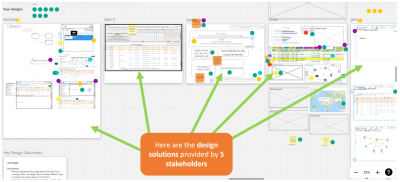
After months of iterating on the fraud investigation platform through these collaboration sessions, I ended up with two different design frameworks for the investigator’s dashboard. Instead of just presenting the “best one” and hoping for buy-in, I ran a voting exercise with PMs, engineers, SMEs, and customer support. Everyone had a voice. The winning design was created and validated with the input of the team, resulting in an outcome that solved many problems for the end user and was owned by the entire team. That’s collaboration!

It is definitely one of the most satisfying projects of my career.
On the other hand, I recently caught up with an old colleague who now serves as a product owner. Her story was a cautionary tale: the design team had gone ahead with a major redesign of an app without looping her in until late in the game. Not surprisingly, the new design missed several key product constraints and business goals. It had to be scrapped and redone, with her now at the table. That experience reinforced what we all know deep down: your best work rarely happens in isolation.
As illustrated in my experience, true collaboration can span many roles. It’s not just between designers and PMs. It can also include QA testers who identify real-world issues, content strategists who ensure our language is clear and inclusive, sales representatives who interact with customers on a daily basis, marketers who understand the brand’s voice, and, of course, customer support agents who are often the first to hear when something goes wrong. The best outcomes arrive when we’re open to different perspectives and inputs.
Why Collaboration Is So Overlooked?
If collaboration is so powerful, why don’t we talk about it more?
In my experience, one reason is the myth of the “lone UX hero”. Many of us entered the field inspired by stories of design geniuses revolutionising products on their own. Our portfolios often reflect that as well. We showcase our solo work, our processes, and our wins. Job descriptions often reinforce the idea of the solo UX designer, listing tool proficiency and deliverables more than soft skills and team dynamics.
And then there’s the team culture within many organisations of “just get the work done”, which often leads to fewer meetings and tighter deadlines. As a result, a sense of collaboration is inefficient and wasted. I have also experienced working with some designers where perfectionism and territoriality creep in — “This is my design” — which kills the open, communal spirit that collaboration needs.
When Collaboration Is The User Research
In an ideal world, we’d always have direct access to users. But let’s be real. Sometimes that just doesn’t happen. Whether it’s due to budget constraints, time limitations, or layers of bureaucracy, talking to end users isn’t always possible. That’s where collaboration with team members becomes even more crucial.
The next best thing to talking to users? Talking to the people who talk to users. Sales teams, customer success reps, tech support, and field engineers. They’re all user researchers in disguise!
On another B2C project, the end users were having trouble completing the key task. My role was to redesign the onboarding experience for an online identity capture tool for end users. I was unable to schedule interviews with end users due to budget and time constraints, so I turned to the sales and tech support teams.
I conducted multiple mini-workshops to identify the most common onboarding issues they had heard directly from our customers. This led to a huge “aha” moment: most users dropped off before the document capture process. They may have been struggling with a lack of instruction, not knowing the required time, or not understanding the steps involved in completing the onboarding process.
That insight reframed my approach, and we ultimately redesigned the flow to prioritize orientation and clear instructions before proceeding to the setup steps. Below is an example of one of the screen designs, including some of the instructions we added.
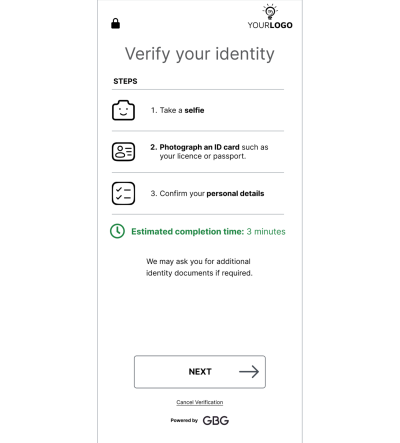
This kind of collaboration is user research. It’s not a substitute for talking to users directly, but it’s a powerful proxy when you have limited options.
But What About Using AI?
Glad you asked! Even AI tools, which are increasingly being used for idea generation, pattern recognition, or rapid prototyping, don’t replace collaboration; they just change the shape of it.
AI can help you explore design patterns, draft user flows, or generate multiple variations of a layout in seconds. It’s fantastic for getting past creative blocks or pressure-testing your assumptions. But let’s be clear: these tools are accelerators, not oracles. As an innovation and strategy consultant Nathan Waterhouse points out, AI can point you in a direction, but it can’t tell you which direction is the right one in your specific context. That still requires human judgment, empathy, and an understanding of the messy realities of users and business goals.
You still need people, especially those closest to your users, to validate, challenge, and evolve any AI-generated idea. For instance, you might use ChatGPT to brainstorm onboarding flows for a SaaS tool, but if you’re not involving customer support reps who regularly hear “I didn’t know where to start” or “I couldn’t even log in,” you’re just working with assumptions. The same applies to engineers who know what is technically feasible or PMs who understand where the business is headed.
AI can generate ideas, but only collaboration turns those ideas into something usable, valuable, and real. Think of it as a powerful ingredient, but not the whole recipe.
“
How To Strengthen Your UX Collaboration Skills?
If collaboration doesn’t come naturally or hasn’t been a focus, that’s okay. Like any skill, it can be practiced and improved. Here are a few ways to level up:
- Cultivate curiosity about your teammates.
Ask engineers what keeps them up at night. Learn what metrics your PMs care about. Understand the types of tickets the support team handles most frequently. The more you care about their challenges, the more they’ll care about yours. - Get comfortable facilitating.
You don’t need to be a certified Design Sprint master, but learning how to run a structured conversation, align stakeholders, or synthesize different points of view is hugely valuable. Even a simple “What’s working? What’s not?” retro can be an amazing starting point in identifying where you need to focus next. - Share early, share often.
Don’t wait until your designs are polished to get input. Messy sketches and rough prototypes invite collaboration. When others feel like they’ve helped shape the work, they’re more invested in its success. - Practice active listening.
When someone critiques your work, don’t immediately defend. Pause. Ask follow-up questions. Reframe the feedback. Collaboration isn’t about consensus; it’s about finding a shared direction that can honour multiple truths. - Co-own the outcome.
Let go of your ego. The best UX work isn’t “your” work. It’s the result of many voices, skill sets, and conversations converging toward a solution that helps users. It’s not “I”, it’s “we” that will solve this problem together.
Conclusion: UX Is A Team Sport
Great design doesn’t emerge from a vacuum. It comes from open dialogue, cross-functional understanding, and a shared commitment to solving real problems for real people.
If there’s one thing I wish every early-career designer knew, it’s this:
Collaboration is not a side skill. It’s the engine behind every meaningful design outcome. And for seasoned professionals, it’s the superpower that turns good teams into great ones.
“
So next time you’re tempted to go heads-down and just “crank out a design,” pause to reflect. Ask who else should be in the room. And invite them in, not just to review your work, but to help create it.
Because in the end, the best UX isn’t just what you make. It’s what you make together.
Further Reading On SmashingMag
- “Presenting UX Research And Design To Stakeholders: The Power Of Persuasion,” Victor Yocco
- “Transforming The Relationship Between Designers And Developers,” Chris Day
- “Effective Communication For Everyday Meetings,” Andrii Zhdan
- “Preventing Bad UX Through Integrated Design Workflows,” Ceara Crawshaw
(yk)

Designing For Neurodiversity
Designing For Neurodiversity Designing For Neurodiversity Vitaly Friedman 2025-06-02T08:00:00+00:00 2025-06-25T15:04:30+00:00 This article is sponsored by TetraLogical Neurodivergent needs are often considered as an edge case that doesn’t fit into common user journeys or flows. Neurodiversity tends to get overlooked in the design process. Or it […]
Accessibility
Designing For Neurodiversity
Vitaly Friedman 2025-06-02T08:00:00+00:00
2025-06-25T15:04:30+00:00
This article is sponsored by TetraLogical
Neurodivergent needs are often considered as an edge case that doesn’t fit into common user journeys or flows. Neurodiversity tends to get overlooked in the design process. Or it is tackled late in the process, and only if there is enough time.
But people aren’t edge cases. Every person is just a different person, performing tasks and navigating the web in a different way. So how can we design better, more inclusive experiences that cater to different needs and, ultimately, benefit everyone? Let’s take a closer look.
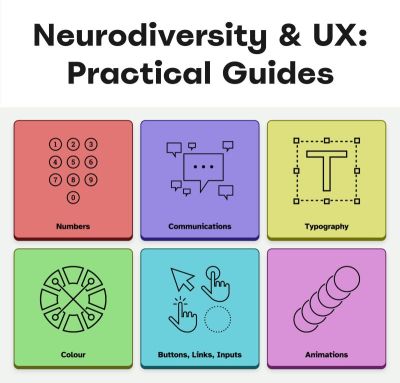
Neurodiversity Or Neurodivergent?
There is quite a bit of confusion about both terms on the web. Different people think and experience the world differently, and neurodiversity sees differences as natural variations, not deficits. It distinguishes between neurotypical and neurodivergent people.
- Neurotypical people see the world in a “typical” and widely perceived as expected way.
- Neurodivergent people experience the world differently, for example, people with ADHD, dyslexia, dyscalculia, synesthesia, and hyperlexia.
According to various sources, around 15–40% of the population has neurodivergent traits. These traits can be innate (e.g., autism) or acquired (e.g., trauma). But they are always on a spectrum, and vary a lot. A person with autism is not neurodiverse — they are neurodivergent.
One of the main strengths of neurodivergent people is how imaginative and creative they are, coming up with out-of-the-box ideas quickly. With exceptional levels of attention, strong long-term memory, a unique perspective, unbeatable accuracy, and a strong sense of justice and fairness.
Being different in a world that, to some degree, still doesn’t accept these differences is exhausting. So unsurprisingly, neurodivergent people often bring along determination, resilience, and high levels of empathy.
Design With People, Not For Them
As a designer, I often see myself as a path-maker. I’m designing reliable paths for people to navigate to their goals comfortably. Without being blocked. Or confused. Or locked out.
That means respecting the simple fact that people’s needs, tasks, and user journeys are all different, and that they evolve over time. And: most importantly, it means considering them very early in the process.
Better accessibility is better for everyone. Instead of making decisions that need to be reverted or refined to be compliant, we can bring a diverse group of people — with accessibility needs, with neurodiversity, frequent and infrequent users, experts, newcomers — in the process, and design with them, rather than for them.
Neurodiversity & Inclusive Design Resources
A wonderful resource that helps us design for cognitive accessibility is Stéphanie Walter’s Neurodiversity and UX toolkit. It includes practical guidelines, tools, and resources to better understand and design for dyslexia, dyscalculia, autism, and ADHD.
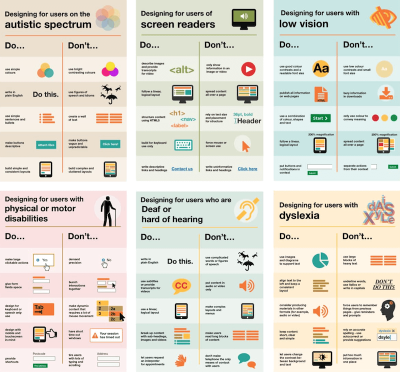
Another fantastic resource is Will Soward’s Neurodiversity Design System. It combines neurodiversity and user experience design into a set of design standards and principles that you can use to design accessible learning interfaces.
Last but not least, I’ve been putting together a few summaries about neurodiversity and inclusive design over the last few years, so you might find them helpful, too:
- ADHD
- Autism
- Children
- Colorblindness
- Deafness
- Dyscalculia
- Dyslexia
- Legibility
- Left-Handed Users
- Mental Health
- Motivation
- Older Adults
- Screen Readers
- Teenagers
A huge thank-you to everyone who has been writing, speaking, and sharing articles, resources, and toolkits on designing for diversity. The topic is often forgotten and overlooked, but it has an incredible impact. 👏🏼👏🏽👏🏾
(vf, il, yk)

Reliably Detecting Third-Party Cookie Blocking In 2025
Reliably Detecting Third-Party Cookie Blocking In 2025 Reliably Detecting Third-Party Cookie Blocking In 2025 Mikhail Prosmitskiy 2025-05-28T10:00:00+00:00 2025-06-25T15:04:30+00:00 The web is beginning to part ways with third-party cookies, a technology it once heavily relied on. Introduced in 1994 by Netscape to support features like virtual shopping carts, cookies have […]
Accessibility
Reliably Detecting Third-Party Cookie Blocking In 2025
Mikhail Prosmitskiy 2025-05-28T10:00:00+00:00
2025-06-25T15:04:30+00:00
The web is beginning to part ways with third-party cookies, a technology it once heavily relied on. Introduced in 1994 by Netscape to support features like virtual shopping carts, cookies have long been a staple of web functionality. However, concerns over privacy and security have led to a concerted effort to eliminate them. The World Wide Web Consortium Technical Architecture Group (W3C TAG) has been vocal in advocating for the complete removal of third-party cookies from the web platform.
Major browsers (Chrome, Safari, Firefox, and Edge) are responding by phasing them out, though the transition is gradual. While this shift enhances user privacy, it also disrupts legitimate functionalities that rely on third-party cookies, such as single sign-on (SSO), fraud prevention, and embedded services. And because there is still no universal ban in place and many essential web features continue to depend on these cookies, developers must detect when third-party cookies are blocked so that applications can respond gracefully.
Don’t Let Silent Failures Win: Why Cookie Detection Still Matters
Yes, the ideal solution is to move away from third-party cookies altogether and redesign our integrations using privacy-first, purpose-built alternatives as soon as possible. But in reality, that migration can take months or even years, especially for legacy systems or third-party vendors. Meanwhile, users are already browsing with third-party cookies disabled and often have no idea that anything is missing.
Imagine a travel booking platform that embeds an iframe from a third-party partner to display live train or flight schedules. This embedded service uses a cookie on its own domain to authenticate the user and personalize content, like showing saved trips or loyalty rewards. But when the browser blocks third-party cookies, the iframe cannot access that data. Instead of a seamless experience, the user sees an error, a blank screen, or a login prompt that doesn’t work.
And while your team is still planning a long-term integration overhaul, this is already happening to real users. They don’t see a cookie policy; they just see a broken booking flow.
Detecting third-party cookie blocking isn’t just good technical hygiene but a frontline defense for user experience.
“
Why It’s Hard To Tell If Third-Party Cookies Are Blocked
Detecting whether third-party cookies are supported isn’t as simple as calling navigator.cookieEnabled. Even a well-intentioned check like this one may look safe, but it still won’t tell you what you actually need to know:
// DOES NOT detect third-party cookie blocking
function areCookiesEnabled() {
if (navigator.cookieEnabled === false) {
return false;
}
try {
document.cookie = "test_cookie=1; SameSite=None; Secure";
const hasCookie = document.cookie.includes("test_cookie=1");
document.cookie = "test_cookie=; Max-Age=0; SameSite=None; Secure";
return hasCookie;
} catch (e) {
return false;
}
}
This function only confirms that cookies work in the current (first-party) context. It says nothing about third-party scenarios, like an iframe on another domain. Worse, it’s misleading: in some browsers, navigator.cookieEnabled may still return true inside a third-party iframe even when cookies are blocked. Others might behave differently, leading to inconsistent and unreliable detection.
These cross-browser inconsistencies — combined with the limitations of document.cookie — make it clear that there is no shortcut for detection. To truly detect third-party cookie blocking, we need to understand how different browsers actually behave in embedded third-party contexts.
How Modern Browsers Handle Third-Party Cookies
The behavior of modern browsers directly affects which detection methods will work and which ones silently fail.
Safari: Full Third-Party Cookie Blocking
Since version 13.1, Safari blocks all third-party cookies by default, with no exceptions, even if the user previously interacted with the embedded domain. This policy is part of Intelligent Tracking Prevention (ITP).
For embedded content (such as an SSO iframe) that requires cookie access, Safari exposes the Storage Access API, which requires a user gesture to grant storage permission. As a result, a test for third-party cookie support will nearly always fail in Safari unless the iframe explicitly requests access via this API.
Firefox: Cookie Partitioning By Design
Firefox’s Total Cookie Protection isolates cookies on a per-site basis. Third-party cookies can still be set and read, but they are partitioned by the top-level site, meaning a cookie set by the same third-party on siteA.com and siteB.com is stored separately and cannot be shared.
As of Firefox 102, this behavior is enabled by default in the Standard (default) mode of Enhanced Tracking Protection. Unlike the Strict mode — which blocks third-party cookies entirely, similar to Safari — the Standard mode does not block them outright. Instead, it neutralizes their tracking capability by isolating them per site.
As a result, even if a test shows that a third-party cookie was successfully set, it may be useless for cross-site logins or shared sessions due to this partitioning. Detection logic needs to account for that.
Chrome: From Deprecation Plans To Privacy Sandbox (And Industry Pushback)
Chromium-based browsers still allow third-party cookies by default — but the story is changing. Starting with Chrome 80, third-party cookies must be explicitly marked with SameSite=None; Secure, or they will be rejected.
In January 2020, Google announced their intention to phase out third-party cookies by 2022. However, the timeline was updated multiple times, first in June 2021 when the company pushed the rollout to begin in mid-2023 and conclude by the end of that year. Additional postponements followed in July 2022, December 2023, and April 2024.
In July 2024, Google has clarified that there is no plan to unilaterally deprecate third-party cookies or force users into a new model without consent. Instead, Chrome is shifting to a user-choice interface that will allow individuals to decide whether to block or allow third-party cookies globally.
This change was influenced in part by substantial pushback from the advertising industry, as well as ongoing regulatory oversight, including scrutiny by the UK Competition and Markets Authority (CMA) into Google’s Privacy Sandbox initiative. The CMA confirmed in a 2025 update that there is no intention to force a deprecation or trigger automatic prompts for cookie blocking.
As for now, third-party cookies remain enabled by default in Chrome. The new user-facing controls and the broader Privacy Sandbox ecosystem are still in various stages of experimentation and limited rollout.
Edge (Chromium-Based): Tracker-Focused Blocking With User Configurability
Edge (which is a Chromium-based browser) shares Chrome’s handling of third-party cookies, including the SameSite=None; Secure requirement. Additionally, Edge introduces Tracking Prevention modes: Basic, Balanced (default), and Strict. In Balanced mode, it blocks known third-party trackers using Microsoft’s maintained list but allows many third-party cookies that are not classified as trackers. Strict mode blocks more resource loads than Balanced, which may result in some websites not behaving as expected.
Other Browsers: What About Them?
Privacy-focused browsers, like Brave, block third-party cookies by default as part of their strong anti-tracking stance.
Internet Explorer (IE) 11 allowed third-party cookies depending on user privacy settings and the presence of Platform for Privacy Preferences (P3P) headers. However, IE usage is now negligible. Notably, the default “Medium” privacy setting in IE could block third-party cookies unless a valid P3P policy was present.
Older versions of Safari had partial third-party cookie restrictions (such as “Allow from websites I visit”), but, as mentioned before, this was replaced with full blocking via ITP.
As of 2025, all major browsers either block or isolate third-party cookies by default, with the exception of Chrome, which still allows them in standard browsing mode pending the rollout of its new user-choice model.
To account for these variations, your detection strategy must be grounded in real-world testing — specifically by reproducing a genuine third-party context such as loading your script within an iframe on a cross-origin domain — rather than relying on browser names or versions.
Overview Of Detection Techniques
Over the years, many techniques have been used to detect third-party cookie blocking. Most are unreliable or obsolete. Here’s a quick walkthrough of what doesn’t work (and why) and what does.
Basic JavaScript API Checks (Misleading)
As mentioned earlier, the navigator.cookieEnabled or setting document.cookie on the main page doesn’t reflect cross-site cookie status:
- In third-party iframes,
navigator.cookieEnabledoften returnstrueeven when cookies are blocked. - Setting
document.cookiein the parent doesn’t test the third-party context.
These checks are first-party only. Avoid using them for detection.
Storage Hacks Via localStorage (Obsolete)
Previously, some developers inferred cookie support by checking if window.localStorage worked inside a third-party iframe — which is especially useful against older Safari versions that blocked all third-party storage.
Modern browsers often allow localStorage even when cookies are blocked. This leads to false positives and is no longer reliable.
Server-Assisted Cookie Probe (Heavyweight)
One classic method involves setting a cookie from a third-party domain via HTTP and then checking if it comes back:
- Load a script/image from a third-party server that sets a cookie.
- Immediately load another resource, and the server checks whether the cookie was sent.
This works, but it:
- Requires custom server-side logic,
- Depends on HTTP caching, response headers, and cookie attributes (
SameSite=None; Secure), and - Adds development and infrastructure complexity.
While this is technically valid, it is not suitable for a front-end-only approach, which is our focus here.
Storage Access API (Supplemental Signal)
The document.hasStorageAccess() method allows embedded third-party content to check if it has access to unpartitioned cookies:
- Chrome
SupportshasStorageAccess()andrequestStorageAccess()starting from version 119. Additionally,hasUnpartitionedCookieAccess()is available as an alias forhasStorageAccess()from version 125 onwards. - Firefox
Supports bothhasStorageAccess()andrequestStorageAccess()methods. - Safari
Supports the Storage Access API. However, access must always be triggered by a user interaction. For example, even callingrequestStorageAccess()without a direct user gesture (like a click) is ignored.
Chrome and Firefox also support the API, and in those browsers, it may work automatically or based on browser heuristics or site engagement.
This API is particularly useful for detecting scenarios where cookies are present but partitioned (e.g., Firefox’s Total Cookie Protection), as it helps determine if the iframe has unrestricted cookie access. But for now, it’s still best used as a supplemental signal, rather than a standalone check.
iFrame + postMessage (Best Practice)
Despite the existence of the Storage Access API, at the time of writing, this remains the most reliable and browser-compatible method:
- Embed a hidden iframe from a third-party domain.
- Inside the iframe, attempt to set a test cookie.
- Use
window.postMessageto report success or failure to the parent.
This approach works across all major browsers (when properly configured), requires no server (kind of, more on that next), and simulates a real-world third-party scenario.
We’ll implement this step-by-step next.
Bonus: Sec-Fetch-Storage-Access
Chrome (starting in version 133) is introducing Sec-Fetch-Storage-Access, an HTTP request header sent with cross-site requests to indicate whether the iframe has access to unpartitioned cookies. This header is only visible to servers and cannot be accessed via JavaScript. It’s useful for back-end analytics but not applicable for client-side cookie detection.
As of May 2025, this feature is only implemented in Chrome and is not supported by other browsers. However, it’s still good to know that it’s part of the evolving ecosystem.
Step-by-Step: Detecting Third-Party Cookies Via iFrame
So, what did I mean when I said that the last method we looked at “requires no server”? While this method doesn’t require any back-end logic (like server-set cookies or response inspection), it does require access to a separate domain — or at least a cross-site subdomain — to simulate a third-party environment. This means the following:
- You must serve the test page from a different domain or public subdomain, e.g.,
example.comandcookietest.example.com, - The domain needs HTTPS (for
SameSite=None; Securecookies to work), and - You’ll need to host a simple static file (the test page), even if no server code is involved.
Once that’s set up, the rest of the logic is fully client-side.
Step 1: Create A Cookie Test Page (On A Third-Party Domain)
Minimal version (e.g., https://cookietest.example.com/cookie-check.html):
<!DOCTYPE html>
<html>
<body>
<script>
document.cookie = "thirdparty_test=1; SameSite=None; Secure; Path=/;";
const cookieFound = document.cookie.includes("thirdparty_test=1");
const sendResult = (status) => window.parent?.postMessage(status, "*");
if (cookieFound && document.hasStorageAccess instanceof Function) {
document.hasStorageAccess().then((hasAccess) => {
sendResult(hasAccess ? "TP_COOKIE_SUPPORTED" : "TP_COOKIE_BLOCKED");
}).catch(() => sendResult("TP_COOKIE_BLOCKED"));
} else {
sendResult(cookieFound ? "TP_COOKIE_SUPPORTED" : "TP_COOKIE_BLOCKED");
}
</script>
</body>
</html>
Make sure the page is served over HTTPS, and the cookie uses SameSite=None; Secure. Without these attributes, modern browsers will silently reject it.
Step 2: Embed The iFrame And Listen For The Result
On your main page:
function checkThirdPartyCookies() {
return new Promise((resolve) => {
const iframe = document.createElement('iframe');
iframe.style.display = 'none';
iframe.src = "https://cookietest.example.com/cookie-check.html"; // your subdomain
document.body.appendChild(iframe);
let resolved = false;
const cleanup = (result, timedOut = false) => {
if (resolved) return;
resolved = true;
window.removeEventListener('message', onMessage);
iframe.remove();
resolve({ thirdPartyCookiesEnabled: result, timedOut });
};
const onMessage = (event) => {
if (["TP_COOKIE_SUPPORTED", "TP_COOKIE_BLOCKED"].includes(event.data)) {
cleanup(event.data === "TP_COOKIE_SUPPORTED", false);
}
};
window.addEventListener('message', onMessage);
setTimeout(() => cleanup(false, true), 1000);
});
}
Example usage:
checkThirdPartyCookies().then(({ thirdPartyCookiesEnabled, timedOut }) => {
if (!thirdPartyCookiesEnabled) {
someCookiesBlockedCallback(); // Third-party cookies are blocked.
if (timedOut) {
// No response received (iframe possibly blocked).
// Optional fallback UX goes here.
someCookiesBlockedTimeoutCallback();
};
}
});
Step 3: Enhance Detection With The Storage Access API
In Safari, even when third-party cookies are blocked, users can manually grant access through the Storage Access API — but only in response to a user gesture.
Here’s how you could implement that in your iframe test page:
<button id="enable-cookies">This embedded content requires cookie access. Click below to continue.</button>
<script>
document.getElementById('enable-cookies')?.addEventListener('click', async () => {
if (document.requestStorageAccess && typeof document.requestStorageAccess === 'function') {
try {
const granted = await document.requestStorageAccess();
if (granted !== false) {
window.parent.postMessage("TP_STORAGE_ACCESS_GRANTED", "*");
} else {
window.parent.postMessage("TP_STORAGE_ACCESS_DENIED", "*");
}
} catch (e) {
window.parent.postMessage("TP_STORAGE_ACCESS_FAILED", "*");
}
}
});
</script>
Then, on the parent page, you can listen for this message and retry detection if needed:
// Inside the same `onMessage` listener from before:
if (event.data === "TP_STORAGE_ACCESS_GRANTED") {
// Optionally: retry the cookie test, or reload iframe logic
checkThirdPartyCookies().then(handleResultAgain);
}
(Bonus) A Purely Client-Side Fallback (Not Perfect, But Sometimes Necessary)
In some situations, you might not have access to a second domain or can’t host third-party content under your control. That makes the iframe method unfeasible.
When that’s the case, your best option is to combine multiple signals — basic cookie checks, hasStorageAccess(), localStorage fallbacks, and maybe even passive indicators like load failures or timeouts — to infer whether third-party cookies are likely blocked.
The important caveat: This will never be 100% accurate. But, in constrained environments, “better something than nothing” may still improve the UX.
Here’s a basic example:
async function inferCookieSupportFallback() {
let hasCookieAPI = navigator.cookieEnabled;
let canSetCookie = false;
let hasStorageAccess = false;
try {
document.cookie = "testfallback=1; SameSite=None; Secure; Path=/;";
canSetCookie = document.cookie.includes("test_fallback=1");
document.cookie = "test_fallback=; Max-Age=0; Path=/;";
} catch (_) {
canSetCookie = false;
}
if (typeof document.hasStorageAccess === "function") {
try {
hasStorageAccess = await document.hasStorageAccess();
} catch (_) {}
}
return {
inferredThirdPartyCookies: hasCookieAPI && canSetCookie && hasStorageAccess,
raw: { hasCookieAPI, canSetCookie, hasStorageAccess }
};
}
Example usage:
inferCookieSupportFallback().then(({ inferredThirdPartyCookies }) => {
if (inferredThirdPartyCookies) {
console.log("Cookies likely supported. Likely, yes.");
} else {
console.warn("Cookies may be blocked or partitioned.");
// You could inform the user or adjust behavior accordingly
}
});
Use this fallback when:
- You’re building a JavaScript-only widget embedded on unknown sites,
- You don’t control a second domain (or the team refuses to add one), or
- You just need some visibility into user-side behavior (e.g., debugging UX issues).
Don’t rely on it for security-critical logic (e.g., auth gating)! But it may help tailor the user experience, surface warnings, or decide whether to attempt a fallback SSO flow. Again, it’s better to have something rather than nothing.
Fallback Strategies When Third-Party Cookies Are Blocked
Detecting blocked cookies is only half the battle. Once you know they’re unavailable, what can you do? Here are some practical options that might be useful for you:
Redirect-Based Flows
For auth-related flows, switch from embedded iframes to top-level redirects. Let the user authenticate directly on the identity provider’s site, then redirect back. It works in all browsers, but the UX might be less seamless.
Request Storage Access
Prompt the user using requestStorageAccess() after a clear UI gesture (Safari requires this). Use this to re-enable cookies without leaving the page.
Token-Based Communication
Pass session info directly from parent to iframe via:
postMessage(with requiredorigin);- Query params (e.g., signed JWT in iframe URL).
This avoids reliance on cookies entirely but requires coordination between both sides:
// Parent
const iframe = document.getElementById('my-iframe');
iframe.onload = () => {
const token = getAccessTokenSomehow(); // JWT or anything else
iframe.contentWindow.postMessage(
{ type: 'AUTH_TOKEN', token },
'https://iframe.example.com' // Set the correct origin!
);
};
// iframe
window.addEventListener('message', (event) => {
if (event.origin !== 'https://parent.example.com') return;
const { type, token } = event.data;
if (type === 'AUTH_TOKEN') {
validateAndUseToken(token); // process JWT, init session, etc
}
});
Partitioned Cookies (CHIPS)
Chrome (since version 114) and other Chromium-based browsers now support cookies with the Partitioned attribute (known as CHIPS), allowing per-top-site cookie isolation. This is useful for widgets like chat or embedded forms where cross-site identity isn’t needed.
Note: Firefox and Safari don’t support the
Partitionedcookie attribute. Firefox enforces cookie partitioning by default using a different mechanism (Total Cookie Protection), while Safari blocks third-party cookies entirely.
But be careful, as they are treated as “blocked” by basic detection. Refine your logic if needed.
Final Thought: Transparency, Transition, And The Path Forward
Third-party cookies are disappearing, albeit gradually and unevenly. Until the transition is complete, your job as a developer is to bridge the gap between technical limitations and real-world user experience. That means:
- Keep an eye on the standards.
APIs like FedCM and Privacy Sandbox features (Topics, Attribution Reporting, Fenced Frames) are reshaping how we handle identity and analytics without relying on cross-site cookies. - Combine detection with graceful fallback.
Whether it’s offering a redirect flow, usingrequestStorageAccess(), or falling back to token-based messaging — every small UX improvement adds up. - Inform your users.
Users shouldn’t be left wondering why something worked in one browser but silently broke in another. Don’t let them feel like they did something wrong — just help them move forward. A clear, friendly message can prevent this confusion.
The good news? You don’t need a perfect solution today, just a resilient one. By detecting issues early and handling them thoughtfully, you protect both your users and your future architecture, one cookie-less browser at a time.
And as seen with Chrome’s pivot away from automatic deprecation, the transition is not always linear. Industry feedback, regulatory oversight, and evolving technical realities continue to shape the time and the solutions.
And don’t forget: having something is better than nothing.
(yk)

Data Vs. Findings Vs. Insights In UX
Data Vs. Findings Vs. Insights In UX Data Vs. Findings Vs. Insights In UX Vitaly Friedman 2025-05-27T13:00:00+00:00 2025-06-25T15:04:30+00:00 In many companies, data, findings, and insights are all used interchangeably. Slack conversations circle around convincing data points, statistically significant findings, reliable insights, and emerging trends. Unsurprisingly, […]
Accessibility
Data Vs. Findings Vs. Insights In UX
Vitaly Friedman 2025-05-27T13:00:00+00:00
2025-06-25T15:04:30+00:00
In many companies, data, findings, and insights are all used interchangeably. Slack conversations circle around convincing data points, statistically significant findings, reliable insights, and emerging trends. Unsurprisingly, conversations often mistake sporadic observations for consistent patterns.
But how impactful is the weight that each of them carries? And how do we turn raw data into meaningful insights to make better decisions? Well, let’s find out.
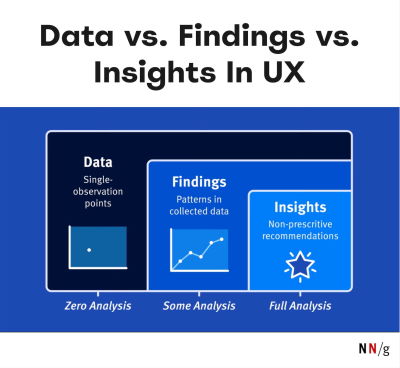
Why It All Matters
At first, it may seem that the differences are very nuanced and merely technical. But when we review inputs and communicate the outcomes of our UX work, we need to be careful not to conflate terminology — to avoid wrong assumptions, wrong conclusions, and early dismissals.
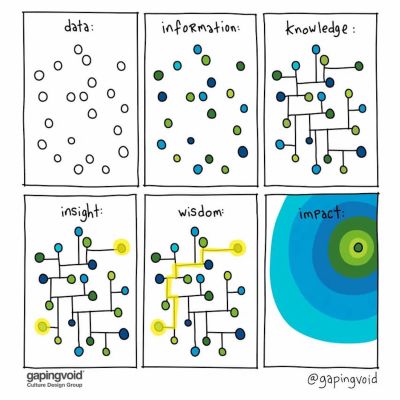
When strong recommendations and bold statements emerge in a big meeting, inevitably, there will be people questioning the decision-making process. More often than not, they will be the loudest voices in the room, often with their own agenda and priorities that they are trying to protect.
As UX designers, we need to be prepared for it. The last thing we want is to have a weak line of thinking, easily dismantled under the premise of “weak research”, “unreliable findings”, “poor choice of users” — and hence dismissed straight away.
Data ≠ Findings ≠ Insights
People with different roles — analysts, data scientists, researchers, strategists — often rely on fine distinctions to make their decisions. The general difference is easy to put together:
- Data is raw observations (logs, notes, survey answers) (what was recorded).
- Findings describe emerging patterns in data but aren’t actionable (what happened).
- Insights are business opportunities (what happened + why + so what).
- Hindsights are reflections of past actions and outcomes (what we learned in previous work).
- Foresights are informed projections, insights with extrapolation (what could happen next).
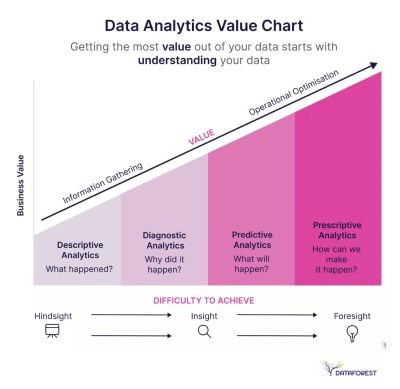
Here’s what it then looks like in real life:
- Data ↓
Six users were looking for ”Money transfer” in “Payments”, and 4 users discovered the feature in their personal dashboard. - Finding ↓
60% of users struggled to find the “Money transfer” feature on a dashboard, often confusing it with the “Payments” section. - Insight ↓
Navigation doesn’t match users’ mental models for money transfers, causing confusion and delays. We recommend renaming sections or reorganizing the dashboard to prioritize “Transfer Money”. It could make task completion more intuitive and efficient. - Hindsight ↓
After renaming the section to “Transfer Money” and moving it to the main dashboard, task success increased by 12%. User confusion dropped in follow-up tests. It proved to be an effective solution. - Foresight ↓
As our financial products become more complex, users will expect simpler task-oriented navigation (e.g., “Send Money”, “Pay Bills“) instead of categories like “Payments”. We should evolve the dashboard towards action-driven IA to meet user expectations.
Only insights create understanding and drive strategy. Foresights shape strategy, too, but are always shaped by bets and assumptions. So, unsurprisingly, stakeholders are interested in insights, not findings. They rarely need to dive into raw data points. But often, they do want to make sure that findings are reliable.
That’s when, eventually, the big question about statistical significance comes along. And that’s when ideas and recommendations often get dismissed without a chance to be explored or explained.
But Is It Statistically Significant?
Now, for UX designers, that’s an incredibly difficult question to answer. As Nikki Anderson pointed out, statistical significance was never designed for qualitative research. And with UX work, we’re not trying to publish academic research or prove universal truths.
What we are trying to do is reach theoretical saturation, the point where additional research doesn’t give us new insights. Research isn’t about proving something is true. It’s about preventing costly mistakes before they happen.
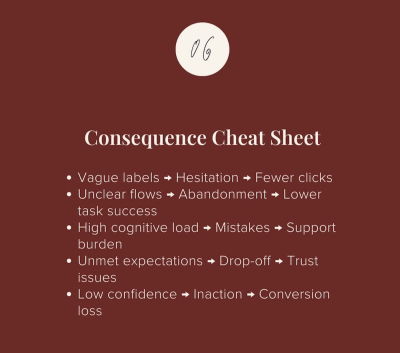
Here are some useful talking points to handle the question:
- Five users per segment often surface major issues, and 10–15 users per segment usually reach saturation. If we’re still getting new insights after that, our scope is too broad.
- “If five people hit the same pothole and wreck their car, how many more do you need before fixing the road?”
- “If three enterprise customers say onboarding is confusing, that’s a churn risk.”
- “If two usability tests expose a checkout issue, that’s abandoned revenue.”
- “If one customer interview reveals a security concern, that’s a crisis waiting to happen.”
- “How many user complaints exactly do we need to take this seriously?”
- “How much revenue exactly are we willing to lose before fixing this issue?”
And: it might not be necessary to focus on the number of participants, but instead, argue about users consistently struggling with a feature, mismatch of expectations, and a clear pattern emerging around a particular pain point.
How To Turn Findings Into Insights
Once we notice patterns emerging, we need to turn them into actionable recommendations. Surprisingly, this isn’t always easy — we need to avoid easy guesses and assumptions as far as possible, as they will invite wrong conclusions.
To do that, you can rely on a very simple but effective framework to turn findings into insights: What Happened + Why + So What:
- “What happened” covers observed behavior and patterns.
- “Why” includes beliefs, expectations, or triggers.
- “So What” addresses impact, risk, and business opportunity.
To better assess the “so what” part, we should pay close attention to the impact of what we have noticed on desired business outcomes. It can be anything from high-impact blockers and confusion to hesitation and inaction.
I can wholeheartedly recommend exploring Findings → Insights Cheatsheet in Nikki Anderson’s wonderful slide deck, which has examples and prompts to use to turn findings into insights.
Stop Sharing Findings — Deliver Insights
When presenting the outcomes of your UX work, focus on actionable recommendations and business opportunities rather than patterns that emerged during testing.
To me, it’s all about telling a good damn story. Memorable, impactful, feasible, and convincing. Paint the picture of what the future could look like and the difference it would produce. That’s where the biggest impact of UX work emerges.
How To Measure UX And Design Impact
Meet Measure UX & Design Impact (8h), a practical guide for designers and UX leads to shape, measure, and explain your incredible UX impact on business. Recorded and updated by Vitaly Friedman. Use the friendly code 🎟 IMPACT to save 20% off today. Jump to the details.

Video + UX Training
$ 495.00 $ 799.00
Get Video + UX Training
25 video lessons (8h) + Live UX Training.
100 days money-back-guarantee.
Video only
25 video lessons (8h). Updated yearly.
Also available as a UX Bundle with 2 video courses.
Further Reading on Smashing Magazine
- “The Human Element: Using Research And Psychology To Elevate Data Storytelling,” Victor Yocco & Angelica Lo Duca
- “Integrations: From Simple Data Transfer To Modern Composable Architectures,” Edoardo Dusi
- “Scaling Success: Key Insights And Practical Takeaways,” Addy Osmani
- “Embracing Introversion In UX,” Victor Yocco
(mrn, yk)

Design System In 90 Days
Design System In 90 Days Design System In 90 Days Vitaly Friedman 2025-05-19T10:00:00+00:00 2025-06-25T15:04:30+00:00 So we want to set up a new design system for your product. How do we get it up and running from scratch? Do we start with key stakeholders, UI audits, […]
Accessibility
Design System In 90 Days
Vitaly Friedman 2025-05-19T10:00:00+00:00
2025-06-25T15:04:30+00:00
So we want to set up a new design system for your product. How do we get it up and running from scratch? Do we start with key stakeholders, UI audits, or naming conventions? And what are some of the critical conversations we need to have early to avoid problems down the line?
Fortunately, there are a few useful little helpers to get started — and they are the ones I tend to rely on quite a bit when initiating any design system projects.
Design System In 90 Days Canvas
Design System in 90 Days Canvas (FigJam template) is a handy set of useful questions to start a design system effort. Essentially, it’s a roadmap to discuss everything from the value of a design system to stakeholders, teams involved, and components to start with.
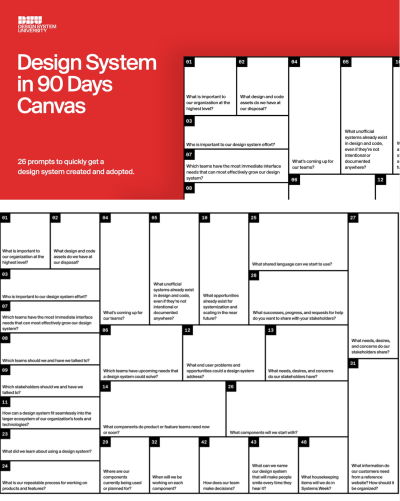
A neat little helper to get a design system up and running — and adopted! — in 90 days. Created for small and large companies that are building a design system or plan to set up one. Kindly shared by Dan Mall.
Practical Design System Tactics
Design System Tactics is a practical overview of tactics to help designers make progress with a design system at every stage — from crafting system principles to component discovery to design system office hours to cross-brand consolidation. Wonderful work by the one-and-only Ness Grixti.
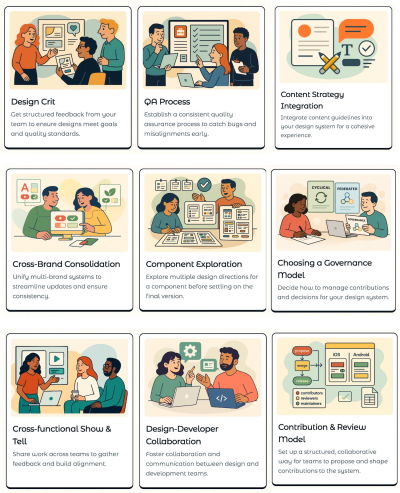
Design System Worksheet (PDF)
Design System Checklist by Nathan Curtis (download the PDF) is a practical 2-page worksheet for a 60-minute team activity, designed to choose the right parts, products, and people for your design system.
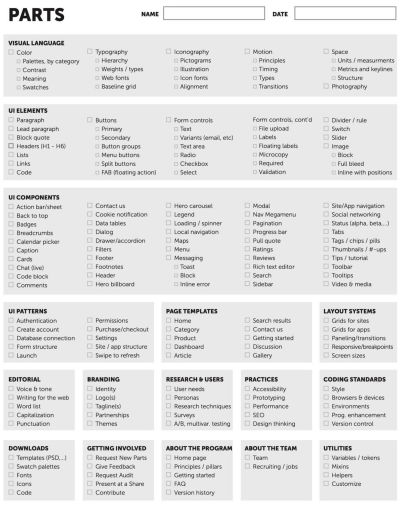
Of course, the point of a design system is not to be fully comprehensive or cover every possible component you might ever need. It’s all about being useful enough to help designers produce quality work faster and being flexible enough to help designers make decisions rather than make decisions for them.
Useful Questions To Get Started With
The value of a design system lies in it being useful and applicable — for a large group of people in the organization. And according to Dan, a good start is to identify where exactly that value would be most helpful to tackle the company’s critical challenges and goals:
- What is important to our organization at the highest level?
- Who is important to our design system effort?
- What unofficial systems already exist in design and code?
- Which teams have upcoming needs that a system could solve?
- Which teams have immediate needs that can grow our system?
- Which teams should we and have we talked to?
- Which stakeholders should we and have we talked to?
- What needs, desires, and concerns do our stakeholders have?
- What components do product or feature teams need now or soon?
- What end-user problems/opportunities could a system address?
- What did we learn about using other design systems?
- What is our repeatable process for working on products?
- What components will we start with?
- What needs, desires, and concerns do our stakeholders share?
- Where are our components currently being used or planned for?
Useful Resources
Here are a few other useful little helpers that might help you in your design system efforts:
- Design System Questions To Answer In First 90 Days, by Dan Mall
- Design System Canvas (PDF / Figjam), by Paavan Buddhdev
- LeanDS Framework (Figma), by Marianne Ashton-Booth
- Useful UX Templates For Designers (Figma Kits), by yours truly, Vitaly Friedman
- Design System Guide, by Romina Kavcic
Wrapping Up
A canvas often acts as a great conversation starter. It’s rarely complete, but it brings up topics and issues that one wouldn’t have discovered on the spot. We won’t have answers to all questions right away, but we can start moving in the right direction to turn a design system effort into a success.
Happy crossing off the right tick boxes!
How To Measure UX And Design Impact
Meet Measure UX & Design Impact (8h), a practical guide for designers and UX leads to shape, measure, and explain your incredible UX impact on business. Recorded and updated by Vitaly Friedman. Use the friendly code 🎟 IMPACT to save 20% off today. Jump to the details.

Video + UX Training
$ 495.00 $ 799.00
Get Video + UX Training
25 video lessons (8h) + Live UX Training.
100 days money-back-guarantee.
Video only
25 video lessons (8h). Updated yearly.
Also available as a UX Bundle with 2 video courses.
Further Reading on Smashing Magazine
- “Build Design Systems With Penpot Components,” Mikołaj Dobrucki
- “How To Turn Your Figma Designs Into Live Apps With Anima Playground,” Anima Team
- “UX And Design Files Organization Template,” Vitaly Friedman
- “The Digital Playbook: A Crucial Counterpart To Your Design System,” Paul Boag
(mrn, yk)











